GE Medical Systems Information Technologies 340T Model 340 Medical Telemetry Transmitter User Manual
GE Medical Systems Information Technologies Inc. Model 340 Medical Telemetry Transmitter
Contents
- 1. User Manual
- 2. Module User Manual
User Manual

Corometrics Model 340
OPERATOR’S MANUAL MANUAL P/N 2003720-001 REV. B
IUPTOCO
Telemetry Receiver
340R
+
COROMETRICS
~
XXX
COROMETRICS
340T
Telemetry Transmitter
REFER TO MANUAL FOR PROPER TRANSDUCERS
ULTRASOUND ECG UA
XXX
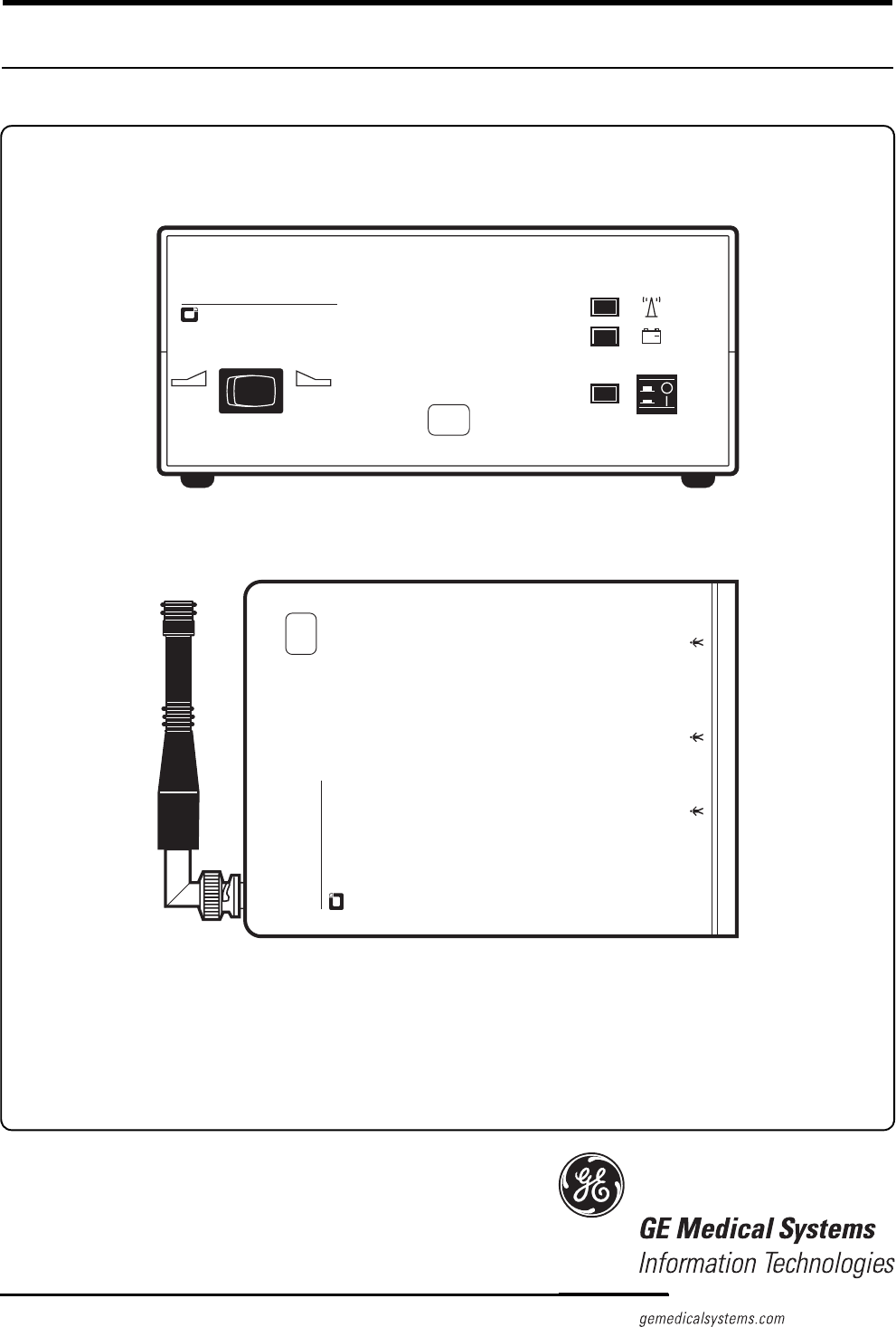
Corometrics Model 340
OPERATOR’S MANUAL MANUAL P/N 2003720-001 REV. B
IUPTOCO
Telemetry Receiver
340R
+
COROMETRICS
~
XXX
COROMETRICS
340T
Telemetry Transmitter
REFER TO MANUAL FOR PROPER TRANSDUCERS
ULTRASOUND ECG UA
XXX

Corometrics and Marquette are registered trademarks of GE Medical Systems Information Technologies. GE is a
registered trademark of General Electric Company. All other product and brand names are trademarks or registered trademarks
of their respective companies. ©2000 GE Medical Systems Information Technologies. All rights reserved. No part of
this manual may be reproduced without the permission of GE Medical Systems Information Technologies.
GUARANTEE
All equipment sold by GE Medical Systems Information Technologies is fully guaranteed as to
materials and workmanship for a period of 1 year. Information Technologies reserves the right to
perform guarantee service operations in its own factory, at an authorized repair station, or in the
customer’s installation.
Our obligation under this guarantee is limited to repairing, or, at our option, replacing any
defective parts of our equipment, except fuses or batteries, without charge, if such defects occur in
normal service.
Claims for damage in shipment should be filed promptly with the transportation company. All
correspondence covering the instrument should specify the model and serial numbers.
GE MEDICAL SYSTEMS Information Technologies
A GE Medical Systems Company
Revision A: 5/00
Revision B: 11/00
GE Medical Systems Information Technologies will make available on request such circuit
diagrams, component diagrams, component parts lists, descriptions, calibration instructions, or
other information which will assist the users or appropriately qualified technical personnel to
repair those parts of the equipment which are classified by Information Technologies as
repairable. Refer to the service manual for further information.
CAUTION: In the United States of America, Federal Law restricts this device to sale by or
on the order of a physician.
!
World Headquarters
8200 West Tower Avenue
Milwaukee, WI 53223 USA
Tel: +414.355.5000
800.558.5120 (US only)
Fax: +414.355.3790
Internet: www.gemedicalsystems.com
Europe / Middle East / Africa
Postfach 60 02 65
D-79032 Freiburg Germany
Tel: +49.761.45.43.0
Fax: +49.761.45.43.233
Asia
11th Floor, The Lee Gardens
33 Hysan Avenue
Causeway Bay Hong Kong
Tel: +852.2100.6300
Fax: +852.2100.6292

Revision B Model 340 Telemetry System i
2003720-001
Contents
Figures . . . . . . . . . . . . . . . . . . . . . . . . . . . . . . . . . . . . . . . . . . v
Tables . . . . . . . . . . . . . . . . . . . . . . . . . . . . . . . . . . . . . . . . . . vii
1Safety . . . . . . . . . . . . . . . . . . . . . . . . . . . . . . . . . . . . . . . . . 1-1
General Information . . . . . . . . . . . . . . . . . . . . . . . . . . . . . . . . . . . . . . . . . . . . . . . . . . 1-2
General Use . . . . . . . . . . . . . . . . . . . . . . . . . . . . . . . . . . . . . . . . . . . . . . . . . . . . . .1-2
Responsibility of the Manufacturer . . . . . . . . . . . . . . . . . . . . . . . . . . . . . . . . . . . . .1-2
Definitions of Terminology . . . . . . . . . . . . . . . . . . . . . . . . . . . . . . . . . . . . . . . . . . . . 1-3
Equipment Safety Information . . . . . . . . . . . . . . . . . . . . . . . . . . . . . . . . . . . . . . . . . 1-4
Warnings . . . . . . . . . . . . . . . . . . . . . . . . . . . . . . . . . . . . . . . . . . . . . . . . . . . . . . . .1-4
Cautions . . . . . . . . . . . . . . . . . . . . . . . . . . . . . . . . . . . . . . . . . . . . . . . . . . . . . . . . 1-7
Equipment Symbols . . . . . . . . . . . . . . . . . . . . . . . . . . . . . . . . . . . . . . . . . . . . . . . . . 1-8
FCC Information . . . . . . . . . . . . . . . . . . . . . . . . . . . . . . . . . . . . . . . . . . . . . . . . . . . . . 1-9
FCC Rules Compliance . . . . . . . . . . . . . . . . . . . . . . . . . . . . . . . . . . . . . . . . . . . . .1-9
FCC RF Exposure Compliance . . . . . . . . . . . . . . . . . . . . . . . . . . . . . . . . . . . . . . .1-9
FCC Service Information . . . . . . . . . . . . . . . . . . . . . . . . . . . . . . . . . . . . . . . . . . . .1-9
2Introduction . . . . . . . . . . . . . . . . . . . . . . . . . . . . . . . . . . . . 2-1
Product Summary . . . . . . . . . . . . . . . . . . . . . . . . . . . . . . . . . . . . . . . . . . . . . . . . . . . 2-2
Product Features . . . . . . . . . . . . . . . . . . . . . . . . . . . . . . . . . . . . . . . . . . . . . . . . . . . . 2-3

ii Model 340 Telemetry System Revision B
2003720-001
3Controls, Indicators, and Connectors . . . . . . . . . . . . . . . 3-1
Model 340R Receiver . . . . . . . . . . . . . . . . . . . . . . . . . . . . . . . . . . . . . . . . . . . . . . . . . 3-2
Model 340R Front Panel . . . . . . . . . . . . . . . . . . . . . . . . . . . . . . . . . . . . . . . . . . . .3-2
Model 340R Rear Panel . . . . . . . . . . . . . . . . . . . . . . . . . . . . . . . . . . . . . . . . . . . . 3-4
Model 340T Transmitter . . . . . . . . . . . . . . . . . . . . . . . . . . . . . . . . . . . . . . . . . . . . . . 3-6
Model 340T Bottom Panel . . . . . . . . . . . . . . . . . . . . . . . . . . . . . . . . . . . . . . . . . . .3-6
Model 340T Top Panel . . . . . . . . . . . . . . . . . . . . . . . . . . . . . . . . . . . . . . . . . . . . . 3-8
Model 340T Rear Panel Battery Compartment . . . . . . . . . . . . . . . . . . . . . . . . . 3-10
4Setup Procedures . . . . . . . . . . . . . . . . . . . . . . . . . . . . . . . 4-1
Connecting the Receiver and Monitor . . . . . . . . . . . . . . . . . . . . . . . . . . . . . . . . . . . 4-2
Models 115, 116, 118, 145, 150, 151, and 155 . . . . . . . . . . . . . . . . . . . . . . . . . . .4-2
120 and 170 Series . . . . . . . . . . . . . . . . . . . . . . . . . . . . . . . . . . . . . . . . . . . . . . . 4-5
Setting Up the Model 340T Transmitter . . . . . . . . . . . . . . . . . . . . . . . . . . . . . . . . . . 4-7
Installing Batteries . . . . . . . . . . . . . . . . . . . . . . . . . . . . . . . . . . . . . . . . . . . . . . . . .4-7
Attaching the Antenna . . . . . . . . . . . . . . . . . . . . . . . . . . . . . . . . . . . . . . . . . . . . . 4-9
Attaching the Carrying Strap . . . . . . . . . . . . . . . . . . . . . . . . . . . . . . . . . . . . . . . . .4-9
Performing a Functional Checkout . . . . . . . . . . . . . . . . . . . . . . . . . . . . . . . . . . . . 4-10
Initial Conditions . . . . . . . . . . . . . . . . . . . . . . . . . . . . . . . . . . . . . . . . . . . . . . . . . .4-10
Testing the Radio Frequency . . . . . . . . . . . . . . . . . . . . . . . . . . . . . . . . . . . . . . . .4-10
Testing the Ultrasound Functions . . . . . . . . . . . . . . . . . . . . . . . . . . . . . . . . . . . 4-11
Testing the ECG Functions . . . . . . . . . . . . . . . . . . . . . . . . . . . . . . . . . . . . . . . . 4-13
Testing the UA Functions . . . . . . . . . . . . . . . . . . . . . . . . . . . . . . . . . . . . . . . . . . 4-14
Testing the Remote Event Marker Function . . . . . . . . . . . . . . . . . . . . . . . . . . . 4-16
Testing the Environment . . . . . . . . . . . . . . . . . . . . . . . . . . . . . . . . . . . . . . . . . . .4-16
5Monitoring via Telemetry . . . . . . . . . . . . . . . . . . . . . . . . . 5-1
Suggestions for Ambulatory Monitoring . . . . . . . . . . . . . . . . . . . . . . . . . . . . . . . . . 5-2
Monitoring Reminders . . . . . . . . . . . . . . . . . . . . . . . . . . . . . . . . . . . . . . . . . . . . . . . . 5-3
General . . . . . . . . . . . . . . . . . . . . . . . . . . . . . . . . . . . . . . . . . . . . . . . . . . . . . . . . .5-3
Ultrasound . . . . . . . . . . . . . . . . . . . . . . . . . . . . . . . . . . . . . . . . . . . . . . . . . . . . . . .5-3
FECG . . . . . . . . . . . . . . . . . . . . . . . . . . . . . . . . . . . . . . . . . . . . . . . . . . . . . . . . . . .5-3
Tocotransducer . . . . . . . . . . . . . . . . . . . . . . . . . . . . . . . . . . . . . . . . . . . . . . . . . . 5-4
IUP . . . . . . . . . . . . . . . . . . . . . . . . . . . . . . . . . . . . . . . . . . . . . . . . . . . . . . . . . . . . .5-4

Revision B Model 340 Telemetry System iii
2003720-001
6Maintenance . . . . . . . . . . . . . . . . . . . . . . . . . . . . . . . . . . . 6-1
General Cleaning Precautions . . . . . . . . . . . . . . . . . . . . . . . . . . . . . . . . . . . . . . . . . 6-2
Cleaning the Transmitter and Receiver . . . . . . . . . . . . . . . . . . . . . . . . . . . . . . . . . . 6-3
7Troubleshooting . . . . . . . . . . . . . . . . . . . . . . . . . . . . . . . . 7-1
Problem Chart . . . . . . . . . . . . . . . . . . . . . . . . . . . . . . . . . . . . . . . . . . . . . . . . . . . . . . 7-2
8Supplies and Accessories . . . . . . . . . . . . . . . . . . . . . . . . 8-1
General . . . . . . . . . . . . . . . . . . . . . . . . . . . . . . . . . . . . . . . . . . . . . . . . . . . . . . . . . . . . 8-2
Paper . . . . . . . . . . . . . . . . . . . . . . . . . . . . . . . . . . . . . . . . . . . . . . . . . . . . . . . . . . . . . . 8-3
Ultrasound . . . . . . . . . . . . . . . . . . . . . . . . . . . . . . . . . . . . . . . . . . . . . . . . . . . . . . . . . 8-4
FECG . . . . . . . . . . . . . . . . . . . . . . . . . . . . . . . . . . . . . . . . . . . . . . . . . . . . . . . . . . . . . . 8-5
Tocotransducer . . . . . . . . . . . . . . . . . . . . . . . . . . . . . . . . . . . . . . . . . . . . . . . . . . . . . 8-6
IUPC . . . . . . . . . . . . . . . . . . . . . . . . . . . . . . . . . . . . . . . . . . . . . . . . . . . . . . . . . . . . . . 8-7
MECG . . . . . . . . . . . . . . . . . . . . . . . . . . . . . . . . . . . . . . . . . . . . . . . . . . . . . . . . . . . . . 8-8
9Technical Specifications . . . . . . . . . . . . . . . . . . . . . . . . . 9-1
Model 340T Transmitter . . . . . . . . . . . . . . . . . . . . . . . . . . . . . . . . . . . . . . . . . . . . . . . 9-2
Model 340R Receiver . . . . . . . . . . . . . . . . . . . . . . . . . . . . . . . . . . . . . . . . . . . . . . . . . 9-4

Revision B Model 340 Telemetry System v
2003720-001
Figures
Figure 3-1.
Model 340R Receiver Front Panel . . . . . . . . . . . . . . . . . . . . . . . . . . . . . . . . . . . . . . . .3-2
Figure 3-2.
Model 340R Receiver Rear Panel . . . . . . . . . . . . . . . . . . . . . . . . . . . . . . . . . . . . . . . .3-4
Figure 3-3.
Model 340T Transmitter Bottom Panel. . . . . . . . . . . . . . . . . . . . . . . . . . . . . . . . . . . . .3-6
Figure 3-4.
Model 340T Transmitter Top Panel . . . . . . . . . . . . . . . . . . . . . . . . . . . . . . . . . . . . . . .3-8
Figure 3-5.
Model 340T Transmitter Rear Panel Battery Compartment . . . . . . . . . . . . . . . . . . . .3-10
Figure 4-1.
Positioning the Receiver. . . . . . . . . . . . . . . . . . . . . . . . . . . . . . . . . . . . . . . . . . . . . . . .4-2
Figure 4-2.
Attaching the Receiver Antenna. . . . . . . . . . . . . . . . . . . . . . . . . . . . . . . . . . . . . . . . . .4-3
Figure 4-3.
Attaching the Receiver Interconnect Cables. . . . . . . . . . . . . . . . . . . . . . . . . . . . . . . . .4-3
Figure 4-4.
Attaching the Monitor Interconnect Cables. . . . . . . . . . . . . . . . . . . . . . . . . . . . . . . . . .4-4
Figure 4-5.
Attaching the Remote Mark Interconnect Cable. . . . . . . . . . . . . . . . . . . . . . . . . . . . . .4-4
Figure 4-6.
Attaching the Receiver Antenna. . . . . . . . . . . . . . . . . . . . . . . . . . . . . . . . . . . . . . . . . .4-5
Figure 4-7.
Attaching the Monitor Interconnect Cable to a 120 Series Monitor . . . . . . . . . . . . . . .4-6
Figure 4-8.
Attaching the Monitor Interconnect Cable to a 170 Series Monitor . . . . . . . . . . . . . . .4-6
Figure 4-9.
Accessing the Batteries . . . . . . . . . . . . . . . . . . . . . . . . . . . . . . . . . . . . . . . . . . . . . . . .4-7
Figure 4-10.
Transmitter Battery Orientation. . . . . . . . . . . . . . . . . . . . . . . . . . . . . . . . . . . . . . . . . . .4-8
Figure 4-11.
Attaching the Transmitter Antenna. . . . . . . . . . . . . . . . . . . . . . . . . . . . . . . . . . . . . . . .4-9

vi Model 340 Telemetry System Revision B
2003720-001
Figure 4-12.
Attaching the Carrying Strap. . . . . . . . . . . . . . . . . . . . . . . . . . . . . . . . . . . . . . . . . . . . .4-9
Figure 4-13.
Applying Power. . . . . . . . . . . . . . . . . . . . . . . . . . . . . . . . . . . . . . . . . . . . . . . . . . . . . .4-10
Figure 4-14.
Connecting an Ultrasound Transducer. . . . . . . . . . . . . . . . . . . . . . . . . . . . . . . . . . . .4-11
Figure 4-15.
Connecting the Headset. . . . . . . . . . . . . . . . . . . . . . . . . . . . . . . . . . . . . . . . . . . . . . .4-12
Figure 4-16.
Connecting an FECG Cable/Legplate . . . . . . . . . . . . . . . . . . . . . . . . . . . . . . . . . . . .4-13
Figure 4-17.
Connecting a Tocotransducer or IUPC Cable . . . . . . . . . . . . . . . . . . . . . . . . . . . . . .4-14

Revision B Model 340 Telemetry System vii
2003720-001
Tables
Table 1-1.
Definitions of Terminology . . . . . . . . . . . . . . . . . . . . . . . . . . . . . . . . . . . . . . . . . . . . . .1-3
Table 1-2.
Equipment Symbols . . . . . . . . . . . . . . . . . . . . . . . . . . . . . . . . . . . . . . . . . . . . . . . . . . .1-8
Table 2-1.
Summary of Monitor Parameters . . . . . . . . . . . . . . . . . . . . . . . . . . . . . . . . . . . . . . . . .2-3
Table 3-1.
Receiver Front Panel . . . . . . . . . . . . . . . . . . . . . . . . . . . . . . . . . . . . . . . . . . . . . . . . . .3-3
Table 3-2.
Receiver Rear Panel. . . . . . . . . . . . . . . . . . . . . . . . . . . . . . . . . . . . . . . . . . . . . . . . . . .3-5
Table 3-3.
Transmitter Bottom Panel. . . . . . . . . . . . . . . . . . . . . . . . . . . . . . . . . . . . . . . . . . . . . . .3-7
Table 3-4.
Transmitter Top Panel . . . . . . . . . . . . . . . . . . . . . . . . . . . . . . . . . . . . . . . . . . . . . . . . .3-9
Table 7-1.
Troubleshooting . . . . . . . . . . . . . . . . . . . . . . . . . . . . . . . . . . . . . . . . . . . . . . . . . . . . . .7-2
Table 8-1.
General Supplies . . . . . . . . . . . . . . . . . . . . . . . . . . . . . . . . . . . . . . . . . . . . . . . . . . . . .8-2
Table 8-2.
Paper Supplies . . . . . . . . . . . . . . . . . . . . . . . . . . . . . . . . . . . . . . . . . . . . . . . . . . . . . . .8-3
Table 8-3.
Ultrasound Supplies . . . . . . . . . . . . . . . . . . . . . . . . . . . . . . . . . . . . . . . . . . . . . . . . . . .8-4
Table 8-4.
FECG Supplies. . . . . . . . . . . . . . . . . . . . . . . . . . . . . . . . . . . . . . . . . . . . . . . . . . . . . . .8-5
Table 8-5.
Tocotransducer Supplies . . . . . . . . . . . . . . . . . . . . . . . . . . . . . . . . . . . . . . . . . . . . . . .8-6
Table 8-6.
IUPC Supplies . . . . . . . . . . . . . . . . . . . . . . . . . . . . . . . . . . . . . . . . . . . . . . . . . . . . . . .8-7
Table 8-7.
MECG Supplies . . . . . . . . . . . . . . . . . . . . . . . . . . . . . . . . . . . . . . . . . . . . . . . . . . . . . .8-8

viii Model 340 Telemetry System Revision B
2003720-001
For your notes

Revision B Model 340 Telemetry System 1-1
2003720-001
Chapter 1
Safety 1
The information presented in this section is important for the safety of
both the patient and operator and also serves to enhance equipment
reliability. This chapter describes how the terms Danger, Warning,
Caution, Important, and Note are used throughout the manual. In
addition, standard equipment symbols are defined.
This section includes the following important information:
General Information. . . . . . . . . . . . . . . . . . . . . . . . . . . . . . . . 1-2
Definitions of Terminology . . . . . . . . . . . . . . . . . . . . . . . . . . 1-3
Equipment Safety Information . . . . . . . . . . . . . . . . . . . . . . . 1-4
Equipment Symbols . . . . . . . . . . . . . . . . . . . . . . . . . . . . . . . . 1-8
FCC Information . . . . . . . . . . . . . . . . . . . . . . . . . . . . . . . . . . 1-9
!

1-2 Model 340 Telemetry System Revision B
2003720-001
Safety: General Information
General Information
General Use
If any equipment is cold to the touch or below ambient temperature,
allow it to stabilize before use.
To ensure patient safety, use only parts and accessories manufactured or
recommended by GE Medical Systems Information Technologies. Parts
and accessories used shall meet the requirements of IEC 601.1.1.
Disposable devices are intended for single use only. They should not be
reused.
Periodically, and whenever the integrity of the equipment is in doubt,
test all functions.
Refer to the "Maternal/Fetal Monitoring Operator’s Manual" for
information concerning the limitations of internal and external fetal
heart rate monitoring techniques.
Responsibility of the Manufacturer
GE Medical Systems Information Technologies (hereinafter Information
Technologies) is responsible for the effects on safety, reliability, and
performance if:
assembly operations, extensions, readjustments, modifications, or
repairs are carried out by persons authorized by Information
Technologies;
the electrical installation of the relevant room complies with the
requirements of appropriate regulations; and
the equipment is used in accordance with the instructions for use.

Revision B Model 340 Telemetry System 1-3
2003720-001
Safety: Definitions of Terminology
Definitions of Terminology
Six types of special notices are used throughout this manual. They are:
Danger, Warning, Caution, Contraindication, Important, and Note. The
warnings and cautions in this safety section relate to the equipment in
general and apply to all aspects of the equipment. Be sure to read the
other chapters because there are additional warnings and cautions which
relate to specific features of the equipment.
When grouped, warnings and cautions are listed alphabetically and do
not imply any order of importance.
Table 1-1. Definitions of Terminology
Danger A DANGER notice indicates an imminently
hazardous situation which, if not avoided, will result
in death or serious injury.
Warning A WARNING indicates a potentially hazardous
situation which, if not avoided, could result in death
or serious injury.
Caution
A CAUTION indicates a potentially hazardous
situation which, if not avoided, may result in minor
or moderate injury. Cautions are also used to
avoid damage to equipment.
Contraindication
A CONTRAINDICATION describes any special
symptom or circumstance that renders the use of a
remedy or the carrying out of a procedure
inadvisable, usually because of a risk.
Important An IMPORTANT notice indicates an emphasized
note. It is something you should be particularly
aware of; something not readily apparent.
Note A NOTE indicates a particular point of information;
something on which to focus your attention.

1-4 Model 340 Telemetry System Revision B
2003720-001
Safety: Equipment Safety Information
Equipment Safety Information
Warnings
:$51,1*6
ACCIDENTAL SPILLS—In the event that fluids are
accidentally spilled on the equipment, take the
equipment out of operation and inspect for damage.
APPLICATION—This equipment is not designed for
direct cardiac connection.
CONDUCTIVE CONNECTIONS—Avoid making any
conductive connections to applied parts (patient
connection) which are likely to degrade safety.
CONDUCTIVE PARTS—Ensure that the conductive
parts of the lead electrodes and associated connectors do
not contact other conductive parts including earth.
CONNECTIONS—The correct way to connect a patient
to the transmitter is to plug the electrode leads into the
patient cable which in turn connects to the
transmitter. The receiver is connected to the wall
socket by the power cord. Do not plug the electrode
leads into the power cord, a wall socket, or an extension
cord.
DEFIBRILLATION—This equipment is not designed for
use with defibrillators.
ELECTRICAL SHOCK—To reduce the risk of electrical
shock, do not remove equipment covers. Refer servicing
to qualified personnel.
ELECTROMAGNETIC INTERFERENCE—Be aware
that strong electromagnetic fields may interfere with
equipment operation. Interference prevents the clear
reception of signals by the device. If the hospital is close
to a strong transmitter such as TV, AM or FM radio,
police or fire stations, a HAM radio operator, an airport,
or cellular phone, their signals could be picked up as
signals by the equipment. If you feel interference is
affecting the equipment, contact your Service
Representative to check the equipment in your
environment.

Revision B Model 340 Telemetry System 1-5
2003720-001
Safety: Equipment Safety Information
:$51,1*6
ELECTROSURGERY—The equipment is not designed
for use with high-frequency surgical devices. In addition,
measurements may be affected in the presence of strong
electromagnetic sources such as electrosurgery
equipment.
EXPLOSION HAZARD—Do not use this equipment in
the presence of flammable anesthetics or inside an
oxygen tent.
GROUNDING—Do not defeat the three-wire grounding
feature of the power cord by means of adaptors, plug
modifications, or other methods. A dangerous shock
hazard to both patient and operator may result.
INSTRUCTIONS—For continued and safe use of this
equipment, it is necessary to follow all listed instructions.
However, the instructions provided in this manual in no
way supersede established medical procedures
concerning patient care. The device does not replace
observation and evaluation of the patient, at regular
intervals, by a qualified care provider who will make
diagnoses and decide on treatments and interventions.
INTERFACING OTHER EQUIPMENT—Monitoring
equipment must be interfaced with other types of medical
equipment by qualified biomedical engineering
personnel. Be certain to consult manufacturers’
specifications to maintain safe operation.
LEAKAGE CURRENT TEST—The interconnection of
auxiliary equipment with this device may increase the
total leakage current. When interfacing with other
equipment, a test for leakage current must be performed
by qualified biomedical engineering personnel before
using with patients. Serious injury or death could result
if the leakage current exceeds applicable standards. The
use of accessory equipment not complying with the
equivalent safety requirements of this equipment may
lead to a reduced level of safety of the resulting system.
Consideration relating to the choice shall include: use of
the accessory in the patient vicinity; and evidence that
the safety certification of the accessory has been
performed in accordance with the appropriate IEC 601.1
and/or IEC 601.1.1 harmonized national standard.

1-6 Model 340 Telemetry System Revision B
2003720-001
Safety: Equipment Safety Information
:$51,1*6
LINE ISOLATION MONITOR TRANSIENTS—Line
isolation monitor transients may resemble actual cardiac
waveforms, and thus cause incorrect heart rate
determinations and alarm activation (or inhibition).
MRI USE—Do not use the equipment during MRI
scanning; conducted current could potentially cause
burns.
PATIENT CABLES AND LEADWIRES—Do not use
patient cables and electrode leads that permit direct
connection to electrical sources. Use only “safety” cables
and leadwires. Use of non-safety patient cables and lead
wires creates risk of inappropriate electrical connection
which may cause patient shock or death.
PACEMAKER PATIENTS—Rate meters may continue to
count the pacemaker rate during occurrences of cardiac
arrest or some arrhythmias. Do not rely entirely upon
rate meter alarms. Keep pacemaker patients under close
surveillance. Refer to your monitor’s operator’s manual
for disclosure of the pacemaker pulse rejection capability.
SIMULTANEOUS DEVICES—Do not simultaneously
connect more than one device that uses electrodes to
detect ECG and/or respiration to the same patient. Use
of more than one device in this manner may cause
improper operation of one or more of the devices.
STRANGULATION—Make sure all patient cables,
leadwires, and tubing are positioned away from the
patient’s head to minimize the risk of accidental
strangulation.

Revision B Model 340 Telemetry System 1-7
2003720-001
Safety: Equipment Safety Information
Cautions
&$87,216
ANNUAL SERVICING—For continued safety and
performance of the equipment, it is recommended that
the calibration, accuracy, and electrical safety of the
equipment be verified on an annual basis by an
Information Technologies Service Representative.
DAILY INSPECTION—It is essential that the
equipment and accessories be inspected prior to every
use.
ENVIRONMENT—The performance of the equipment
has not been tested in certain areas, such as x-ray and
imaging suites. The equipment is not recommended for
use in these environments.
PERFORMANCE—Report all problems experienced with
the equipment. If the equipment is not working properly,
contact your Service Representative for service. The
equipment should not be used if it is not working
properly.

1-8 Model 340 Telemetry System Revision B
2003720-001
Safety: Equipment Symbols
Equipment Symbols
The following is a list of symbols used on products manufactured by
Information Technologies. Some symbols may not appear on your
equipment.
Table 1-2. Equipment Symbols
ATTENTION: Consult accompanying documents.
TYPE B EQUIPMENT. Type B equipment is
suitable for intentional external and internal
application to the patient, excluding direct cardiac
application.
TYPE BF EQUIPMENT. Type BF equipment is
suitable for intentional external and internal
application to the patient, excluding direct cardiac
application. Type BF equipment has an F-type
applied part.
DEFIBRILLATOR-PROOF TYPE BF EQUIPMENT:
Type BF equipment is suitable for intentional
external and internal application to the patient,
excluding direct cardiac application. Type BF
equipment is type B equipment with an F-type
isolated (floating) part. The paddles indicate the
equipment is defibrillator proof.
ALTERNATING CURRENT (AC).
IPX1 DRIP PROOF.
EQUIPOTENTIALITY.
OPOWER OFF: disconnection from the mains.
IPOWER ON: connection to the mains.
!

Revision B Model 340 Telemetry System 1-9
2003720-001
Safety: FCC Information
FCC Information
FCC Rules Compliance
This equipment complies with Part 15 of FCC rules. Operation is subject
to the condition that this device does not cause harmful interference.
FCC RF Exposure Compliance
,03257$17
RF EXPOSURE—To comply with FCC RF exposure
compliance requirements, users should avoid grasping
the antenna for any extended period of time while the
device is in operation.
FCC Service Information
Servicing the radio frequency transmitter and receiver sections of the
Model 340 Telemetry System requires an FCC General Radio Telephone
License.
Any changes or modifications made to the Model 340 Telemetry System
that are not expressly approved by Information Technologies, could void the
user’s authority to operate this equipment.

1-10 Model 340 Telemetry System Revision B
2003720-001
For your notes

2-2 Model 340 Telemetry System Revision B
2003720-001
Introduction: Product Summary
Product Summary
The Corometrics Model 340 Telemetry System (Model 340R Receiver and
Model 340T Transmitter) provides a wireless means of transmitting
heart rate and uterine activity signals from an ambulatory mother to a
bedside fetal or maternal/fetal monitor. The system operates with the
following Corometrics brand monitors; if your monitor is not listed, check
with your saleperson or service representative for a more current list.
Model 115
Model 116
Model 118
120 Series*
Model 145
Model 150
Model 151
Model 155
170 Series
127(The Model 340 Telemetry
System does not support fetal
movement detection.
The system monitors ultrasound, ECG (FECG or MECG), and uterine
activity (TOCO or IUPC) signals individually or in combination. Refer to
your monitor’s operator’s manual as needed.
*A 120 Series Monitor requires a Communications Board in order to interface to a Model 340 Telemetry System. If
your monitor does not have this option, an upgrade kit is available as cat. no. (REF) 1559BAO. Contact your
Service Representative for more information.
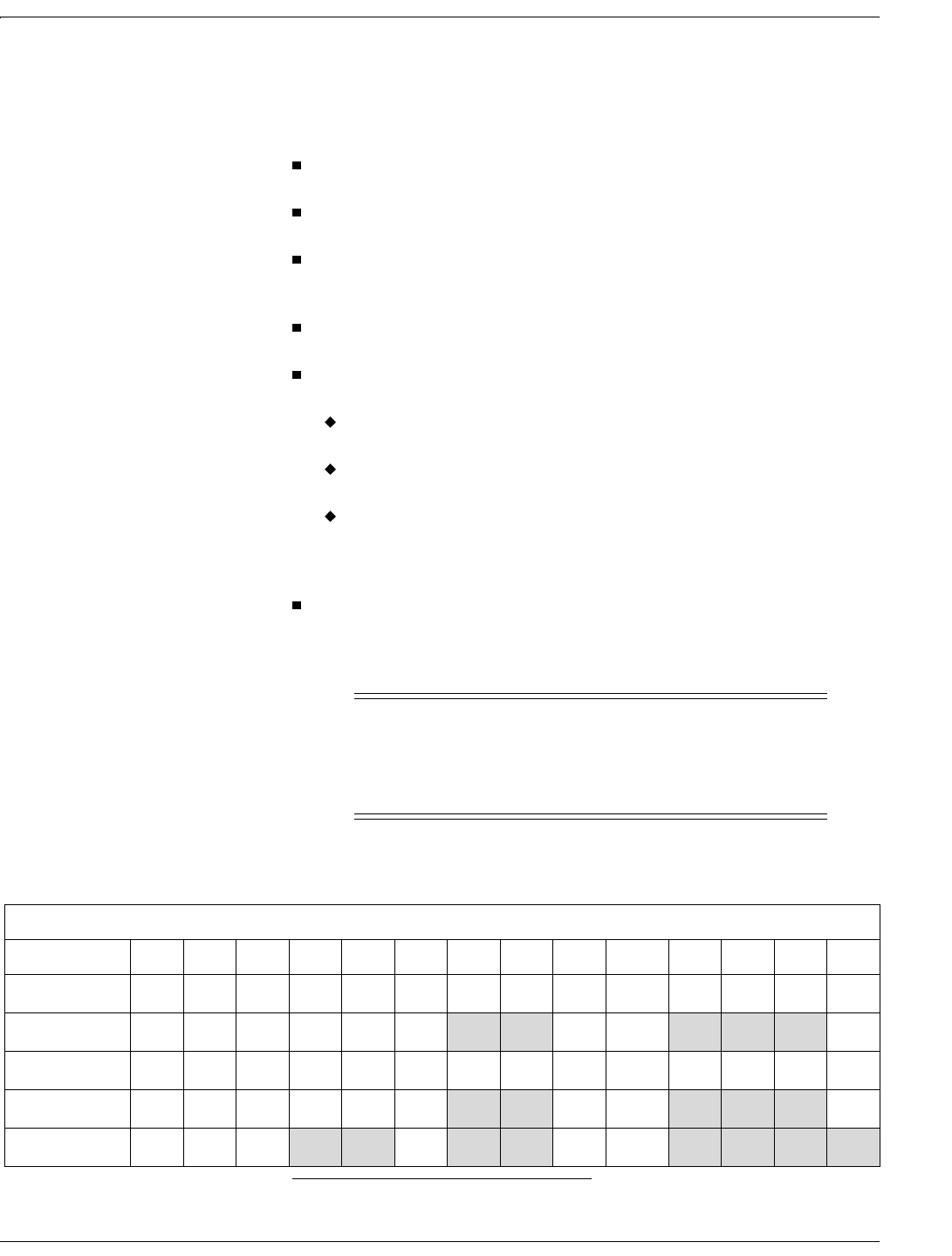
Revision B Model 340 Telemetry System 2-3
2003720-001
Introduction: Product Features
Product Features
The following is a summary of product features:
Battery operated transmitter provides up to 20 hours* of continuous
transmission when operated with fresh batteries.
A Low Battery indicator, accompanied by an audio indicator, signals
an impending low-battery condition.
A transmitter headset* allows the patient or staff to hear the
ultrasonically detected heartbeats for reassurance as well as to verify
proper transducer placement.
A Signal Quality indicator verifies the strength of the radio
transmission signal.
Transducers are quickly and easily interchangeable amongst the
Model 340 Telemetry System and most Corometrics brand monitors:
Models 116, 118, 150, 151, 155, and 170 Series: transducers are
interchangeable.
120 Series: ECG rectangular connector cables are not compatible;
round connector cables are compatible.
Models 115 and 145: cat. no. (REF) 5600 ultrasound transducers
cannot be used with a Model 340. Use only cat. no. (REF) 5700
transducers when the using a Model 115 or 145 with a Model 340
Telemetry System.
Provides simultaneous monitoring of two heart rates (twins or
maternal/fetal) when used with a monitor supporting these
parameters. Refer to Table 2-1 for a summary of monitor parameters.
,03257$17
INSTRUCTIONS—The operator should review and be
familiar with the operator’s manual for the fetal or
maternal/fetal monitor as well as the "Maternal/Fetal
Monitoring Operator’s Manual".
*Use of the headset will deplete the batteries more rapidly.
Table 2-1. Summary of Monitor Parameters
115 116 118 126 128 129 145 150 151 151D 155 171 172 173
TOCO ááááááááá á áááá
IUPC áááááá áá á
US ááááááááá á áááá
FECG áááááá áá á
MECG ááá ááá

2-4 Model 340 Telemetry System Revision B
2003720-001
For your notes

Revision B Model 340 Telemetry System 3-1
2003720-001
Chapter 3
Controls, Indicators, and
Connectors 3
This section describes all controls, indicators, and connectors on a Model
340 Telemetry System.
Model 340R Receiver . . . . . . . . . . . . . . . . . . . . . . . . . . . . . . . 3-2
Model 340T Transmitter . . . . . . . . . . . . . . . . . . . . . . . . . . . . 3-6

3-2 Model 340 Telemetry System Revision B
2003720-001
Controls, Indicators, and Connectors: Model 340R Receiver
Model 340R Receiver
Model 340R Front Panel
Figure 3-1. Model 340R Receiver Front Panel
IUPTOCO
Telemetry Receiver
340R
+
COROMETRICS
~
XXX
AB
C
D
E

Revision B Model 340 Telemetry System 3-3
2003720-001
Controls, Indicators, and Connectors: Model 340R Receiver
Table 3-1. Receiver Front Panel
Name Description
AUA Mode Selector
Switch
This switch communicates the active uterine
activity mode to the fetal or maternal/fetal monitor:
When monitoring with a tocotransducer, set the
switch to the TOCO position.
When monitoring with an intrauterine pressure
catheter, set the switch to the IUP position.
B Channel Number
The channel number is the customer-designated
receiving frequency of the Model 340R Receiver.
For each telemetry system, the channel number of
the receiver must be identical to the channel
number of the transmitter. Also, if you have more
than one telemetry system, or other RF devices,
each system must have a unique channel number.
CPower Switch and
Indicator
The Power switch turns the receiver on (I) and off
(O). When set to on, the green Power indicator
illuminates.
D Low Battery Indicator
The red Low Battery indicator flashes when you
have approximately 10 minutes of Model 340T
Transmitter battery power remaining. The Low
Battery indicator stops flashing and lights
continuously as soon as the battery is depleted.
E Signal Indicator
The green Signal indicator lights continuously
when the receiver is accepting radio frequency
signals from the transmitter. The Signal indicator
flashes if the signal strength is weak or marginal.

3-4 Model 340 Telemetry System Revision B
2003720-001
Controls, Indicators, and Connectors: Model 340R Receiver
Model 340R Rear Panel
Note: Antenna shown removed.
Figure 3-2. Model 340R Receiver Rear Panel
ANTENNA
OUTPUTS TO MONITOR
CONNECT TO
COROMETRICS
MONITORS ONLY
ULTRASOUND ECG UA
!
WARNING: TO REDUCE FIRE HAZARD
REPLACE FUSE AS MARKED.
CAUTION
!
120Vac
~
120V ~ 50-60HZ 30W
0.25A SLOW BLOW
A
ED
C
B
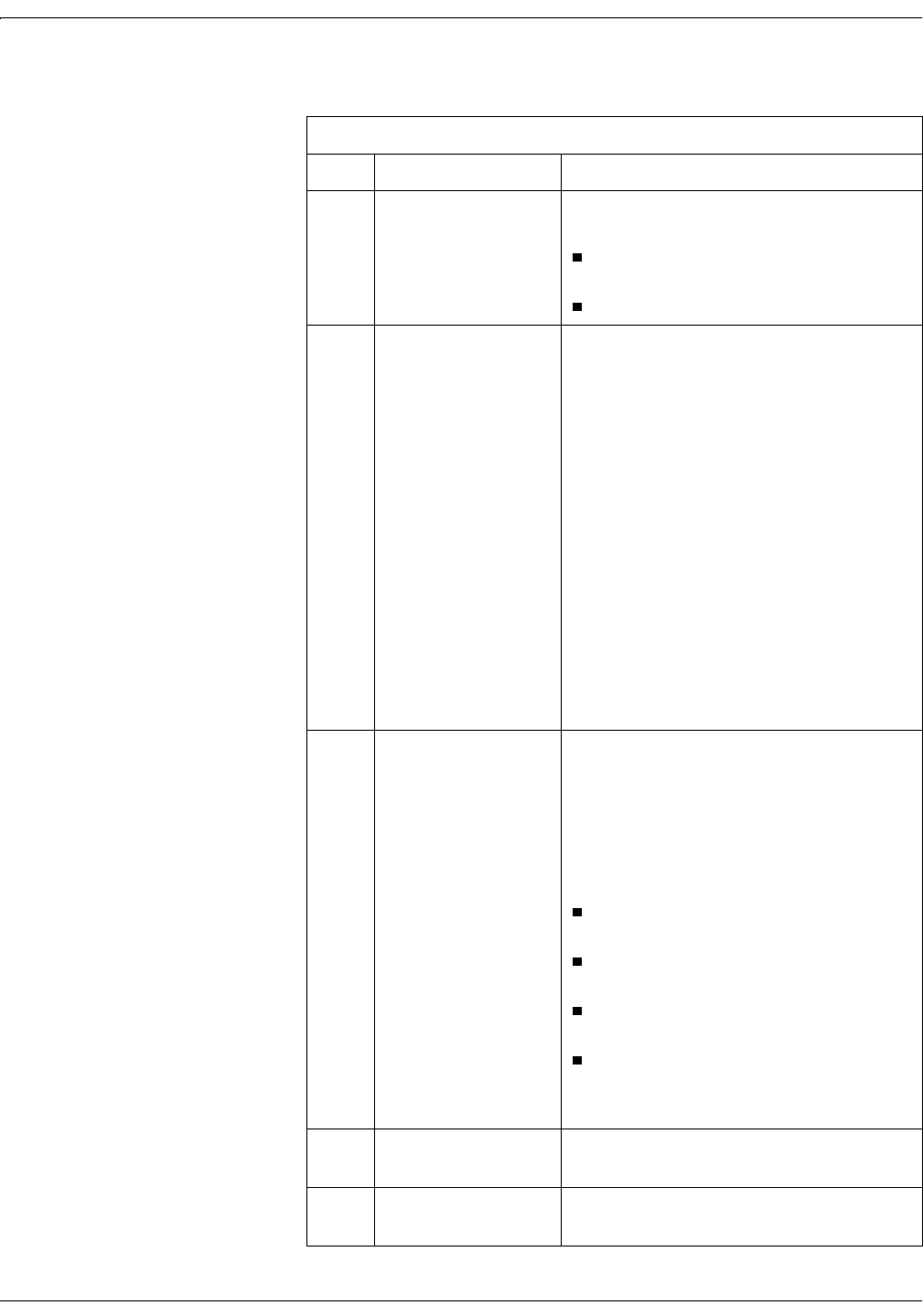
Revision B Model 340 Telemetry System 3-5
2003720-001
Controls, Indicators, and Connectors: Model 340R Receiver
Table 3-2. Receiver Rear Panel
Name Description
AAC Line Connector and
Fuseholder Module
This module houses the AC-line input connector
and the main fuses for the Model 340R Receiver:
100–120 VAC: requires two, 1 A slow-blow
fuses.
220–240 VAC: requires two, 1 A time-lag fuses.
BAuxiliary Output
Connector
This connector is used with 120 and 170 Series
Monitors only. Do not use this connection method
for Models 115, 116, 118, 145, 150, 151, and 155
Monitors.
This connector outputs the US, ECG, UA, and
Mark signals, acquired by telemetry, to a 120 or
170 Series Monitor. See page 4-5 for complete
interconnection details.
As soon as any telemetry mode is detected, the
front panel of the 120 or 170 Series Monitor is
disabled and all front panel inputs are ignored.
In other words, telemetry and monitor modes
cannot be “mixed and matched’; you must use
telemetry only or direct monitoring only.
For proper operation with a 170 Series Monitor,
disconnect all transducers from the front panel
of the monitor.
CUS, ECG, UA, and Mark
Connectors
These connectors are used with Models 115, 116,
118, 145, 150, 151, and 155 Monitors only. Do not
use this connection method for 120 and 170 Series
Monitors.
Each connector outputs the respective signal,
acquired by telemetry, to the fetal or maternal/fetal
monitor:
US: light grey connector which outputs the
ultrasound signal.
ECG: grey connector which outputs the FECG or
MECG signal.
UA: white connector which outputs the TOCO or
IUPC signal.
Mark: connector which outputs the Event Mark
signal.
See page 4-2 for complete interconnection details.
D Antenna Connector Twist-on connector for attaching the Model 340R
Receiver antenna.
E Equipotential Lug Binding post terminal directly connected to the
chassis for use as an equipotentiality connection.
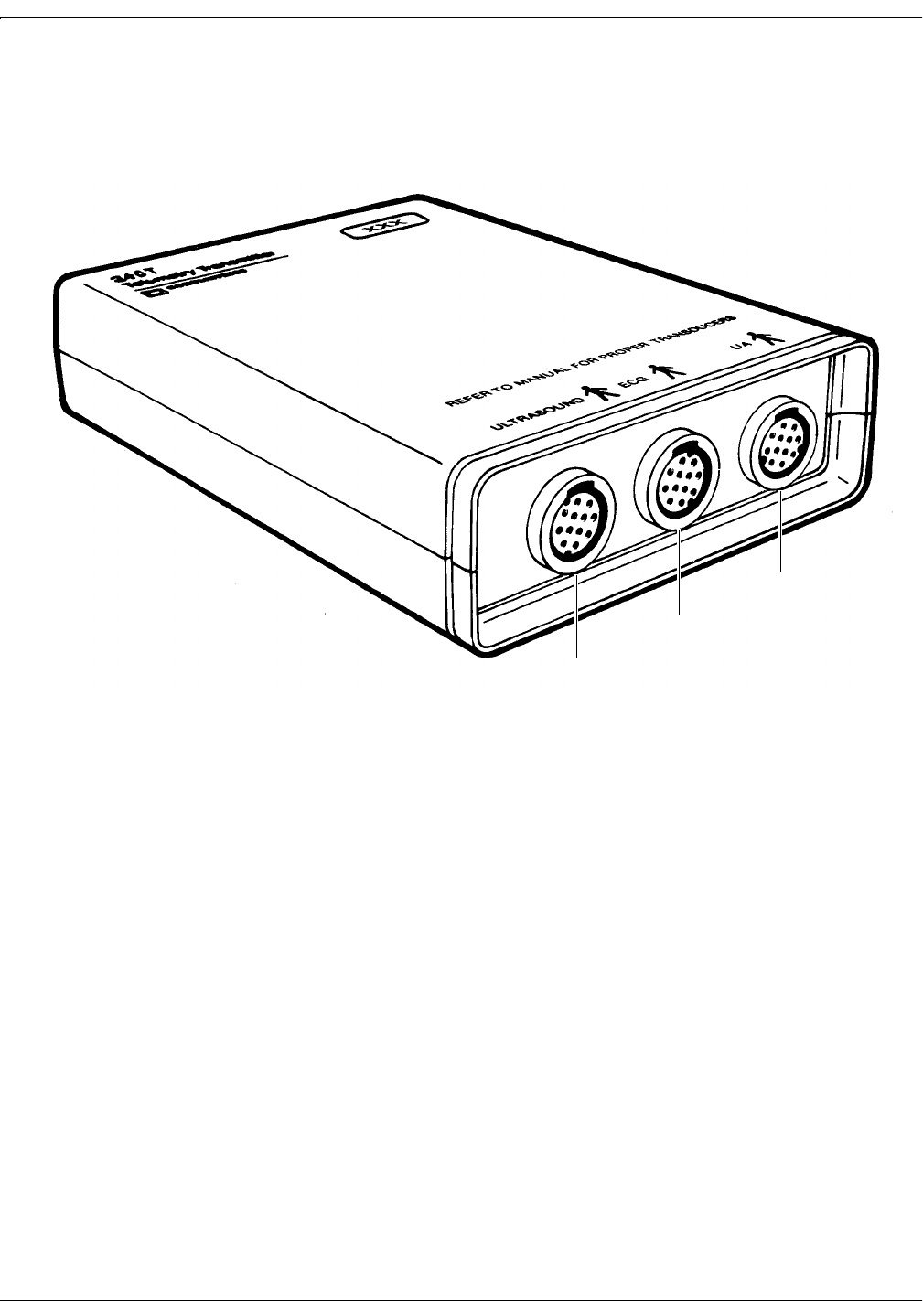
3-6 Model 340 Telemetry System Revision B
2003720-001
Controls, Indicators, and Connectors: Model 340T Transmitter
Model 340T Transmitter
Model 340T Bottom Panel
Figure 3-3. Model 340T Transmitter Bottom Panel
A
C
B

Revision B Model 340 Telemetry System 3-7
2003720-001
Controls, Indicators, and Connectors: Model 340T Transmitter
Table 3-3. Transmitter Bottom Panel
Name Description
A Ultrasound Input
Connect a Corometrics 5700 Series pulsed
Doppler ultrasound transducer to this light gray
receptacle.
Corometrics 5600 Series continuous-wave
ultrasound transducers are not compatible with
the Model 340 Telemetry System. The 5600
Series Transducer was designed for use with
Models 115 and 145 Monitors and Models 320
and 330 Telemetry Systems.
B ECG Input
Connect an FECG cable/legplate or MECG cable
plug to this grey receptacle. This connector is
compatible with all round-connector FECG/MECG
patient cables used with Corometrics-brand
monitors.
C UA Input Connect a tocotransducer, IUPC, or strain gauge
transducer plug to this white receptacle. Contact
your Sales Representative about compatibility.

3-8 Model 340 Telemetry System Revision B
2003720-001
Controls, Indicators, and Connectors: Model 340T Transmitter
Model 340T Top Panel
Note: Antenna shown removed.
Figure 3-4. Model 340T Transmitter Top Panel
ABCDEA

Revision B Model 340 Telemetry System 3-9
2003720-001
Controls, Indicators, and Connectors: Model 340T Transmitter
Table 3-4. Transmitter Top Panel
Name Description
A Loops Loops for attaching the carrying strap.
B Headset Connector Connect the headset to this receptacle to listen to
the fetal heart rate derived from ultrasound.
CRemote Event Mark
Connector
Connect a Corometrics Remote Event Marker to
this receptacle. When the marker’s button is
pressed for at least one second, an event mark
signal is transmitted and one of the following marks
prints on the strip chart paper:
: This annotation is commonly used to record
an “event.” This mark is available on all
Corometrics-brand monitors.
: This annotation is commonly used as an
indication that the mother has perceived fetal
movement. (Refer to your monitor’s operator’s
manual to learn if your monitor supports this
feature. Refer to your monitor’s service manual
for information about enabling the option.)
D Power Switch Moving the switch to the on position (I) turns on the
Model 340T Transmitter; moving the switch to the
off position (O), turns off the transmitter.
E Antenna Connector Twist-on connector for attaching the Model 340T
Transmitter antenna.
F
M
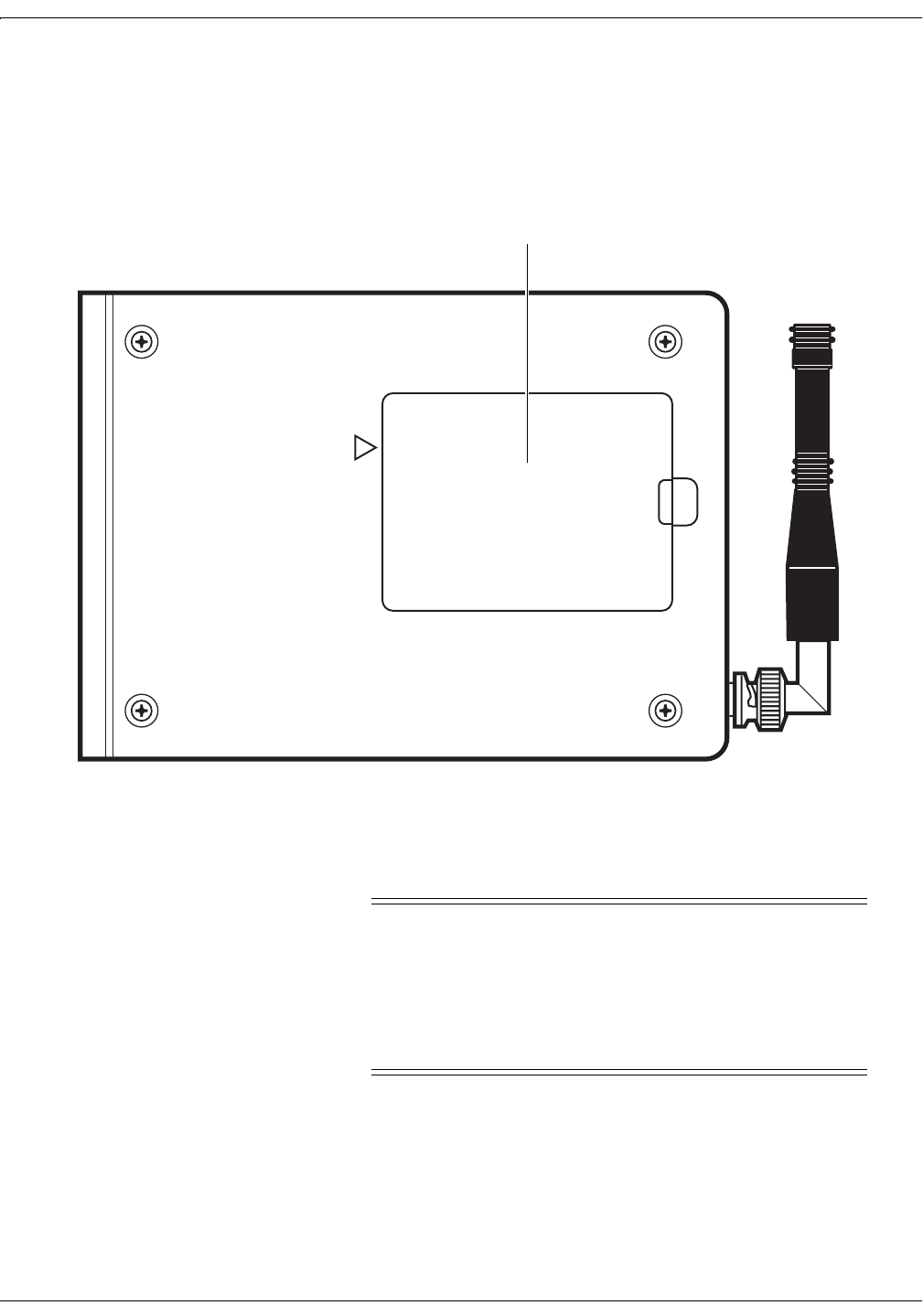
3-10 Model 340 Telemetry System Revision B
2003720-001
Controls, Indicators, and Connectors: Model 340T Transmitter
Model 340T Rear Panel Battery Compartment
Figure 3-5. Model 340T Transmitter Rear Panel Battery Compartment
The battery compartment holds four “AA” alkaline batteries.
&$87,21
BATTERY STRENGTH—When the battery power is low,
the transmitter emits a chirping sound every 4–5
seconds. This signals approximately 10 minutes of
remaining battery power. The chirping continues until
the battery power is completely depleted, at which time
the Model 340T stops transmitting data.
DANGER: POSSIBLE EXPLOSION HAZARD IF USED
IN THE PRESENCE OF FLAMMABLE ANESTHETICS.
CAUTION: REFER SERVICE ONLY TO QUALIFIED PERSONNEL
!
BATTERY COMPARTMENT
Battery Compartment

Revision B Model 340 Telemetry System 4-1
2003720-001
Chapter 4
Setup Procedures 4
This section contains step-by-step instructions for connecting and testing
your Model 340 Telemetry System.
,03257$17
CHANNEL NUMBERS—Ensure that the Model 340R
Receiver and Model 340T Transmitter are operating on
the same frequency; the channel numbers must be
identical. The channel number label is located on the
front of the Model 340R and on the side of the Model
340T.
If you have more than one telemetry system, make sure
that each transmitter/receiver pair operates on a unique
frequency.
Connecting the Receiver and Monitor. . . . . . . . . . . . . . . . . . 4-2
Setting Up the Model 340T Transmitter . . . . . . . . . . . . . . . 4-7
Performing a Functional Checkout. . . . . . . . . . . . . . . . . . . 4-10

4-2 Model 340 Telemetry System Revision B
2003720-001
Setup Procedures: Connecting the Receiver and Monitor
Connecting the Receiver and Monitor
There are two types of interconnection methods depending on the model
of your fetal or maternal/fetal monitor. Check your monitor model
number prior to making any connections.
Models 115, 116, 118, 145, 150, 151, and 155
1. Turn off both the monitor and the Model 340R Receiver.
2. Place the receiver on top of, or near, the monitor.
Note: Model 118 shown.
Figure 4-1. Positioning the Receiver
MATERNAL / FETAL MONITOR
118
Maternal
BP
ULTRASOUND ULTRASOUND 2 ECG
ECG
UA
ECG AND SpO2 ELECTRICALL
ELECTRICALL
Y ISOLATED
REFER TO MANUAL FOR PROPER TRANSDUCERS
Volume Volume BP Stop Setup Select
BP Start
Start
BP Auto
Alarm
Alarm
Cancel
Maternal
Maternal
SpO2
4305AAO
COROMETRICS MEDICAL SYSTEMS,
4305AAO
FHR bpm
90
120
150
180
240
210
IUPTOCO
Telemetry Receiver
340R
+
COROMETRIC
XX
X
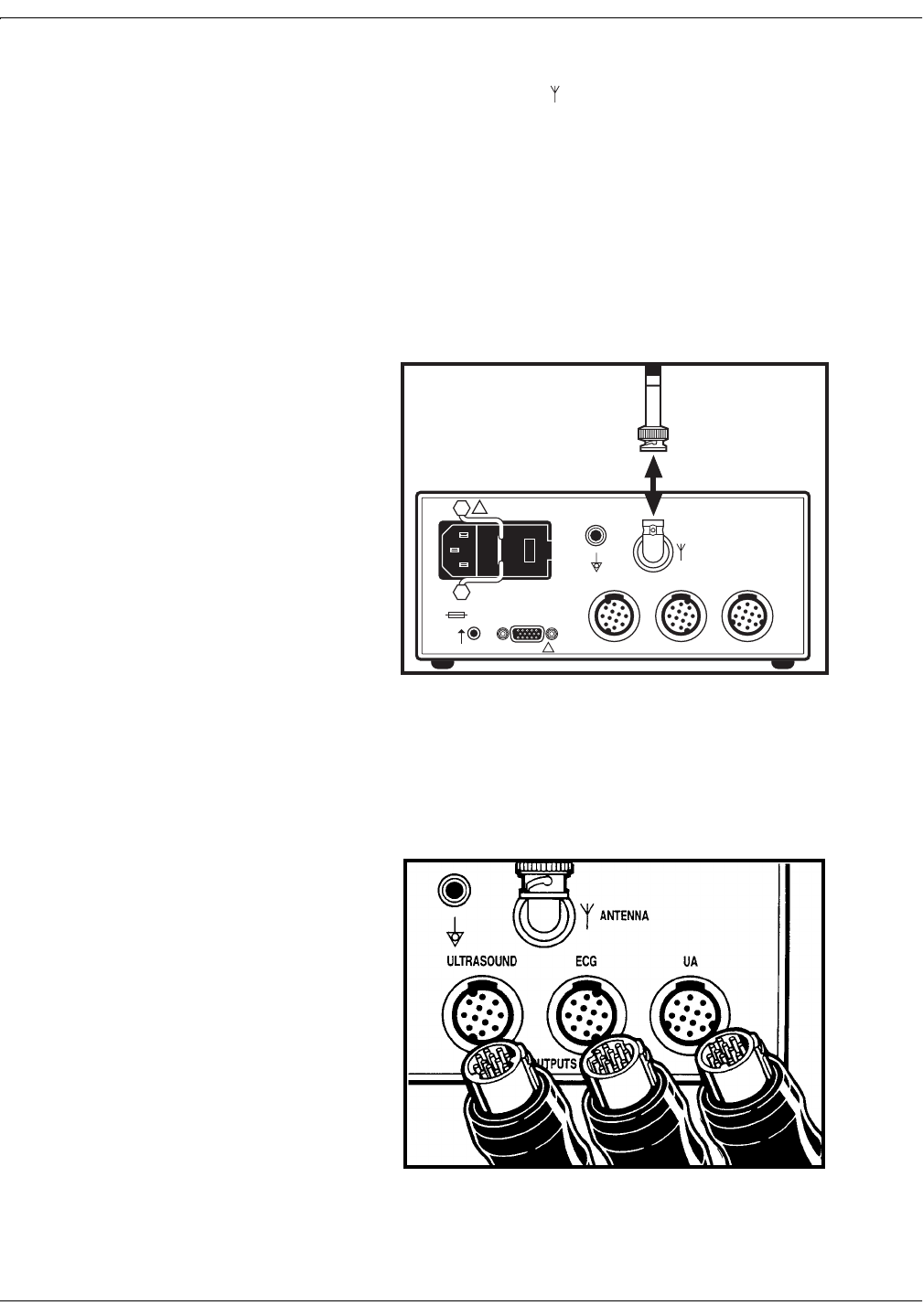
Revision B Model 340 Telemetry System 4-3
2003720-001
Setup Procedures: Connecting the Receiver and Monitor
3. Insert the receiver antenna (longer of the two antennas) into the rear
panel Antenna connector ; rotate the attachment collar in a
clockwise direction until snug.
127(A Remote Antenna Bracket, cat. no. (REF) 1441AAO, is
available for attaching the antenna when the receiver will be
enclosed in a cart or cabinet. Refer to the Installation
Instructions, part no. (REF) 14153AA, included with the
bracket; or contact your Biomedical Engineering Department
for assistance. To attach the antenna to the BNC connector
on the bracket, rotate the antenna attachment collar in a
clockwise direction until snug.
Figure 4-2. Attaching the Receiver Antenna
4. Connect the appropriate ultrasound, ECG, and uterine activity
interconnect cables to the corresponding Ultrasound, ECG, and UA
connectors on the receiver rear panel.
Figure 4-3. Attaching the Receiver Interconnect Cables
ANTENNA
OUTPUTS TO MONITOR
CONNECT TO
COROMETRICS
MONITORS ONLY
ULTRASOUND ECG UA
!
WARNING: TO REDUCE FIRE HAZARD
REPLACE FUSE AS MARKED.
CAUTION
!
120Vac
~
120V ~ 50-60HZ 30W
0.25A SLOW BLOW

4-4 Model 340 Telemetry System Revision B
2003720-001
Setup Procedures: Connecting the Receiver and Monitor
5. Connect the remaining ends of the cables to the color-coded
Ultrasound, ECG, and UA input connectors on the front or side panel of
the monitor.
Note: Model 118 shown.
Figure 4-4. Attaching the Monitor Interconnect Cables
6. Connect one end of the Remote Event Mark interconnect cable to the
connector on the receiver rear panel; connect the other end to the
Remote Marks connector on the rear or side panel of the monitor.
Note: Model 118 shown.
Figure 4-5. Attaching the Remote Mark Interconnect Cable

Revision B Model 340 Telemetry System 4-5
2003720-001
Setup Procedures: Connecting the Receiver and Monitor
120 and 170 Series
,03257$17
120 SERIES COMMUNICATIONS OPTION—A 120
Series Monitor requires a Communications Board in
order to interface to a Model 340 Telemetry System. If
your monitor does not have this option, an upgrade kit is
available as cat. no. (REF) 1559BAO. Contact your
Service Representative for more information.
1. Turn off both the monitor and the Model 340R Receiver.
2. Place the receiver on top of, or near, the monitor.
3. Insert the receiver antenna (longer of the two antennas) into the rear
panel Antenna connector ; rotate the attachment collar in a
clockwise direction until snug.
127(A Remote Antenna Bracket, cat. no. (REF) 1441AAO, is
available for attaching the antenna when the receiver will be
enclosed in a cart or cabinet. Refer to the Installation
Instructions, part no. (REF) 14153AA, included with the
bracket; or contact your Biomedical Engineering Department
for assistance. To attach the antenna to the BNC connector
on the bracket, rotate the antenna attachment collar in a
clockwise direction until snug.
Figure 4-6. Attaching the Receiver Antenna
ANTENNA
OUTPUTS TO MONITOR
CONNECT TO
COROMETRICS
MONITORS ONLY
ULTRASOUND ECG UA
!
WARNING: TO REDUCE FIRE HAZARD
REPLACE FUSE AS MARKED.
CAUTION
!
120Vac
~
120V ~ 50-60HZ 30W
0.25A SLOW BLOW
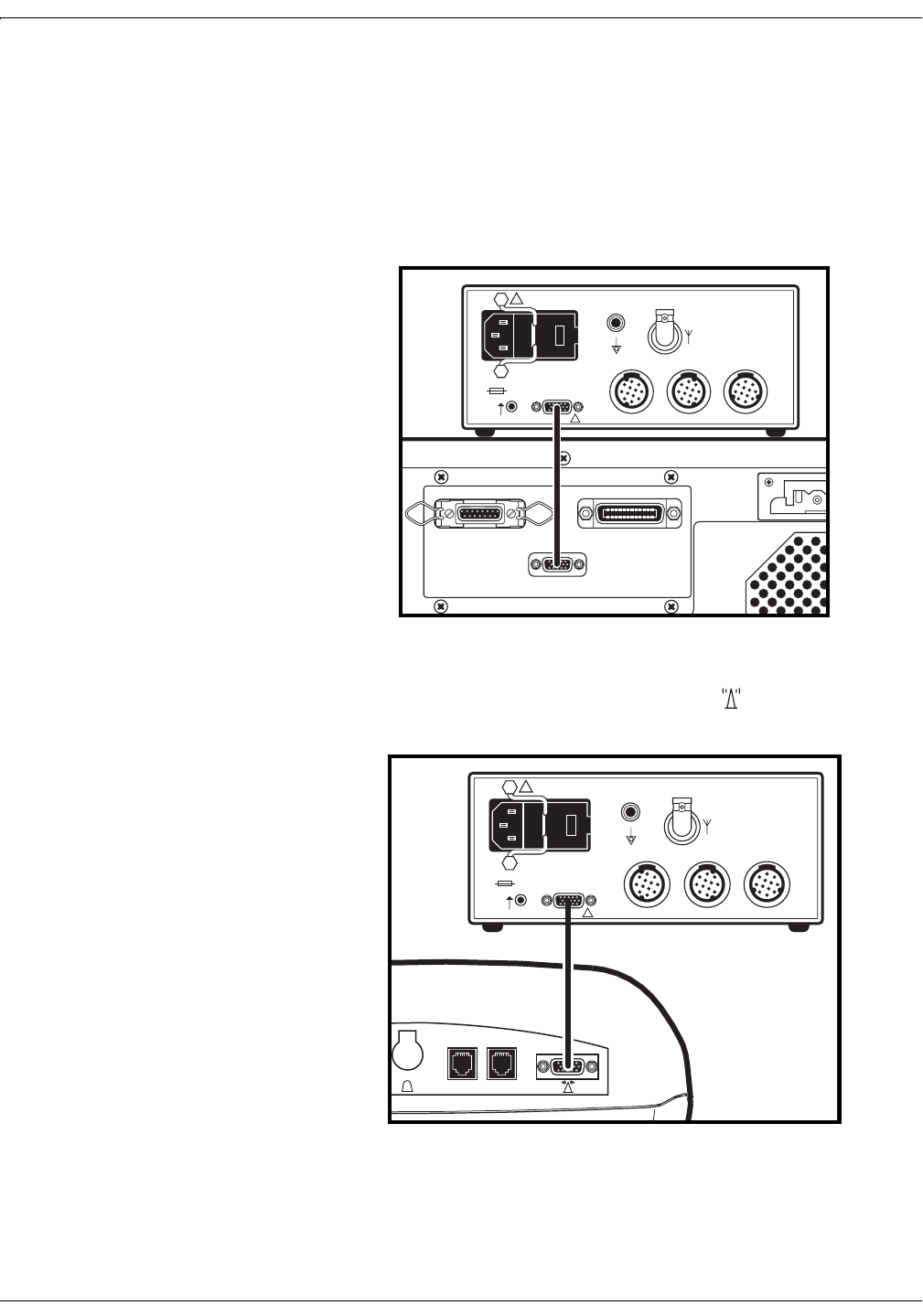
4-6 Model 340 Telemetry System Revision B
2003720-001
Setup Procedures: Connecting the Receiver and Monitor
4. Plug one end of the interconnection cable into the Auxiliary Output
connector (Connect to Corometrics Monitor Only) on the receiver rear
panel.
5. Plug the other end into the respective telemetry connector on the real
panel of the monitor:
120 Series: Connect to J101.
Figure 4-7. Attaching the Monitor Interconnect Cable to a 120 Series Monitor
170 Series: Connect to the receptacle labeled .
Figure 4-8. Attaching the Monitor Interconnect Cable to a 170 Series Monitor
CAUTION: FEDERAL
LAW RESTRICTS
THIS
DEVICE TO SALE BY
OR ON THE ORDER
OF
A PHYSICIAN.
LEG P
L
TESTE
R
CONNECT TO
COROMETRICS
DATA ENTRY SYSTEMS
ONLY
CONNECT TO
COROMETRICS
SERIES 400 MONITORS
ONLY
CONNECT TO COROMETRICS
TELEMETRY RECEIVERS
ONLY
J10
2
J10
3
J10
1
ANTENNA
OUTPUTS TO MONITOR
CONNECT TO
COROMETRICS
MONITORS ONLY
ULTRASOUND ECG UA
!
WARNING: TO REDUCE FIRE HAZARD
REPLACE FUSE AS MARKED.
CAUTION
!
120Vac
~
120V ~ 50-60HZ 30W
0.25A SLOW BLOW
PUSH
RS232
1
RS232
2
ANTENNA
OUTPUTS TO MONITOR
CONNECT TO
COROMETRICS
MONITORS ONLY
ULTRASOUND ECG UA
!
WARNING: TO REDUCE FIRE HAZARD
REPLACE FUSE AS MARKED.
CAUTION
!
120Vac
~
120V ~ 50-60HZ 30W
0.25A SLOW BLOW
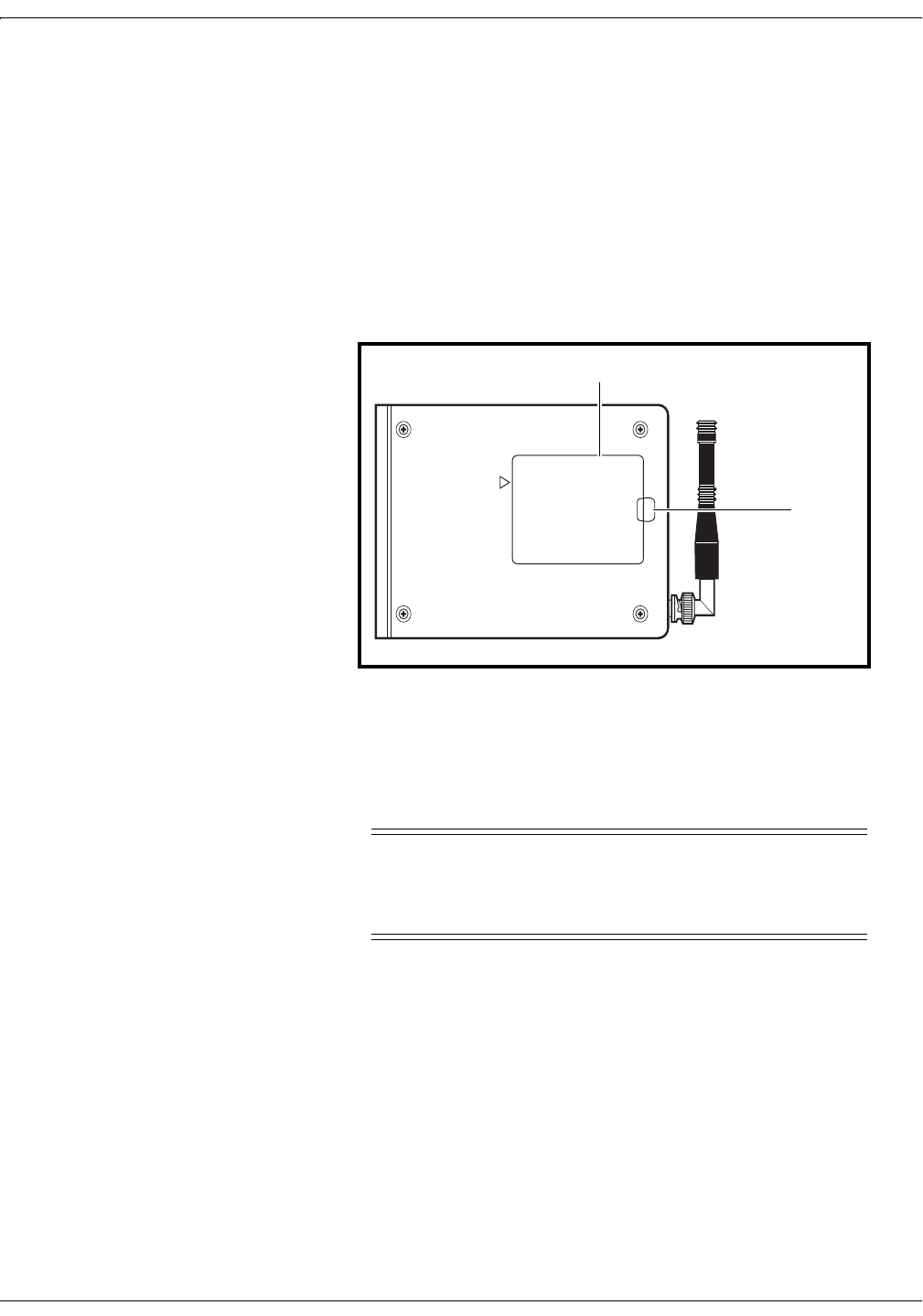
Revision B Model 340 Telemetry System 4-7
2003720-001
Setup Procedures: Setting Up the Model 340T Transmitter
Setting Up the Model 340T Transmitter
Installing Batteries
127(If the Model 340T
Transmitter will not be used for an
extended period of time, remove
the batteries to prevent damage
due to battery leakage.
1. Turn off the Model 340T Transmitter.
2. Locate the battery compartment cover plate on the transmitter rear
panel.
3. Remove the cover plate. Use your thumb to lift the raised end.
Figure 4-9. Accessing the Batteries
4. Remove the depleted batteries.
&$87,21
BATTERY DISPOSAL—Follow the battery
manufacturer’s recommendations or your hospital policy
for the disposal of used batteries.
DANGER: POSSIBLE EXPLOSION HAZARD IF USED
IN THE PRESENCE OF FLAMMABLE ANESTHETICS.
CAUTION: REFER SERVICE ONLY TO QUALIFIED PERSONNEL
!
BATTERY COMPARTMENT
Battery Compartment
Lift
Here

4-8 Model 340 Telemetry System Revision B
2003720-001
Setup Procedures: Setting Up the Model 340T Transmitter
5. Insert four new “AA” alkaline batteries, observing the polarity
markings in the battery compartment.
Note: Antenna shown removed
Figure 4-10. Transmitter Battery Orientation
6. Replace the battery compartment cover plate. Insert the lip of the
cover in the lower portion of the compartment opening; swing the
other end of the cover down and snap into place.
BATTERY COMPARTMENT
!
DANGER: POSSIBLE EXPLOSION HAZARD IF USED
IN THE PRESENCE OF FLAMMABLE ANESTHETICS.
CAUTION: REFER SERVICE ONLY TO QUALIFIED PERSONNEL
+
+
+
+
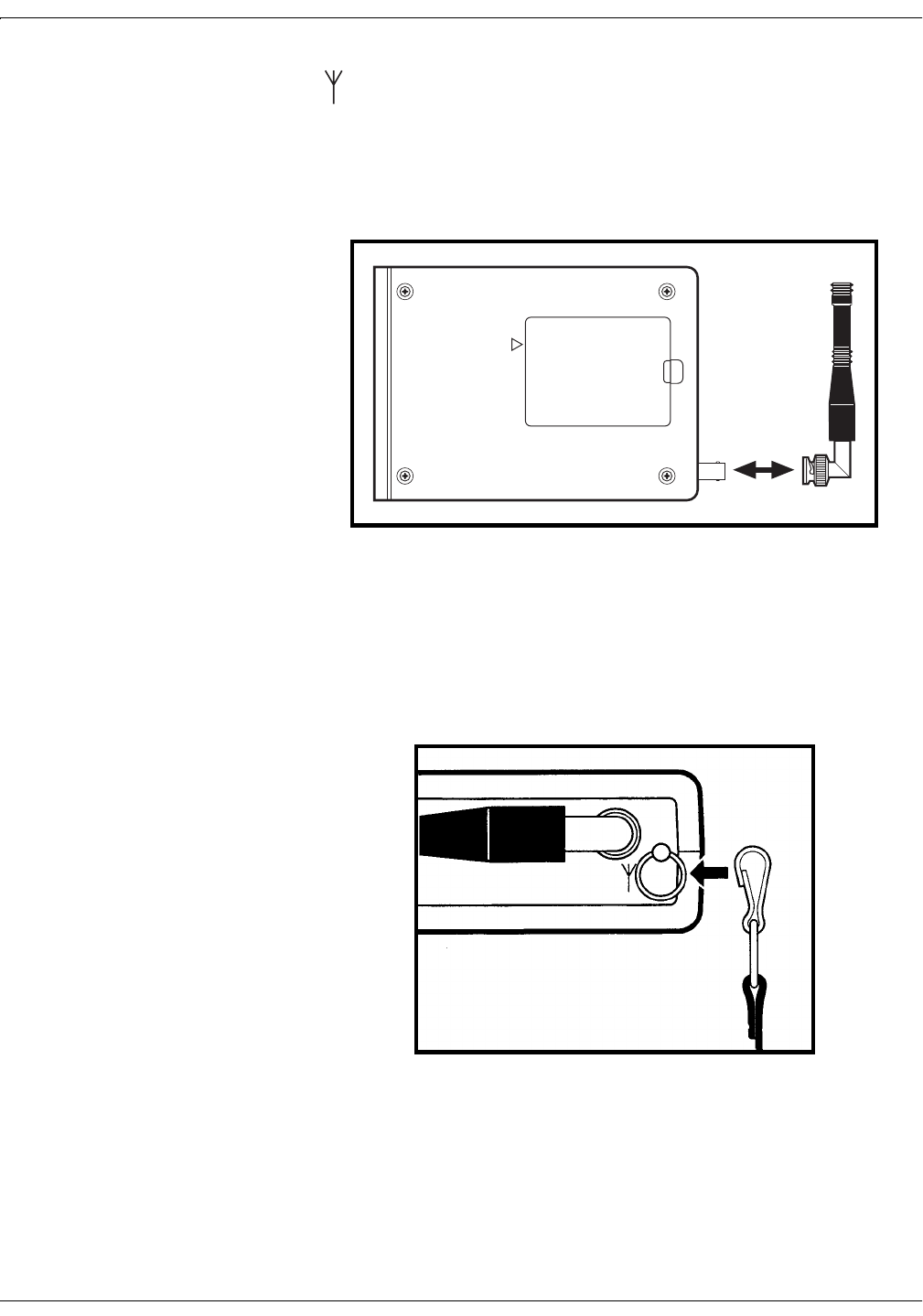
Revision B Model 340 Telemetry System 4-9
2003720-001
Setup Procedures: Setting Up the Model 340T Transmitter
Attaching the Antenna
Insert the transmitter antenna (shorter of the two antennas) into the top
panel Antenna connector; rotate the attachment collar in a clockwise
direction until snug.
Figure 4-11. Attaching the Transmitter Antenna
Attaching the Carrying Strap
Secure the metal clips at each end of the carrying strap to the belt
attachment loops on each side of the transmitter.
Figure 4-12. Attaching the Carrying Strap
DANGER: POSSIBLE EXPLOSION HAZARD IF USED
IN THE PRESENCE OF FLAMMABLE ANESTHETICS.
CAUTION: REFER SERVICE ONLY TO QUALIFIED PERSONNEL
!
BATTERY COMPARTMENT

4-10 Model 340 Telemetry System Revision B
2003720-001
Setup Procedures: Performing a Functional Checkout
Performing a Functional Checkout
Initial Conditions
Turn on the Model 340T Transmitter, the Model 340R Receiver, and the
monitor attached to the receiver.
Figure 4-13. Applying Power
Testing the Radio Frequency
1. Check the status of the Signal indicator on the Model 340R
Receiver:
Continuous Green: indicates the transmitter is active and the
batteries have adequate capacity.
Flashing Green: indicates the signal strength is weak or
marginal.
2. Check the status of the Battery indicator on the Model 340R
Receiver:
Off: the transmitter batteries have power.
Flashing Red: the transmitter batteries are low and should be
replaced before further patient use.
Continuous Red: the transmitter batteries are depleted.
+
+
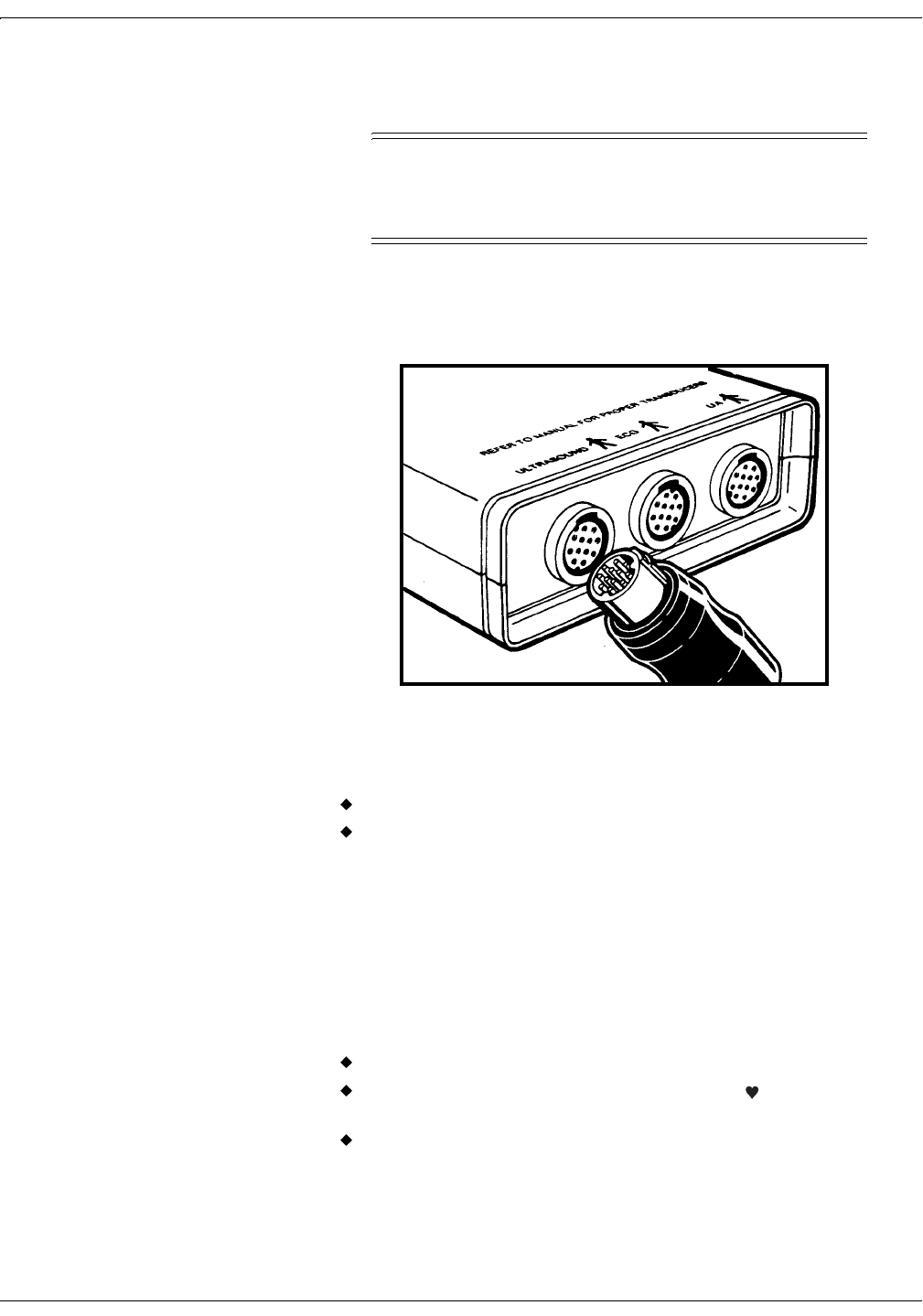
Revision B Model 340 Telemetry System 4-11
2003720-001
Setup Procedures: Performing a Functional Checkout
Testing the Ultrasound Functions
,03257$17
TRANSDUCER TYPE—Use only Corometrics 5700
Series Ultrasound Transducers with the Model 340
Telemetry System.
1. Plug an ultrasound transducer into the Ultrasound connector on the
transmitter.
Figure 4-14. Connecting an Ultrasound Transducer
2. Verify the following:
Models 115, 145: The corresponding FHR display reads 0 BPM.
Models 116, 118, 150, 151, 118, 155 and Series 120, 170: The
corresponding FHR display shows “– – –”.
If the display fails to illuminate, ensure that the corresponding
interconnection cable is firmly attached to both the monitor and the
receiver.
3. Use your finger to gently rub the ultrasound transducer face in a
rhythmic manner. Try to maintain a steady rate and verify the
following on the monitor:
the corresponding FHR display value responds to the rubbing;
the corresponding FHR heartbeat indicator responds to the
input; and
the ultrasound audio tones are synchronous with the transducer
stroking.
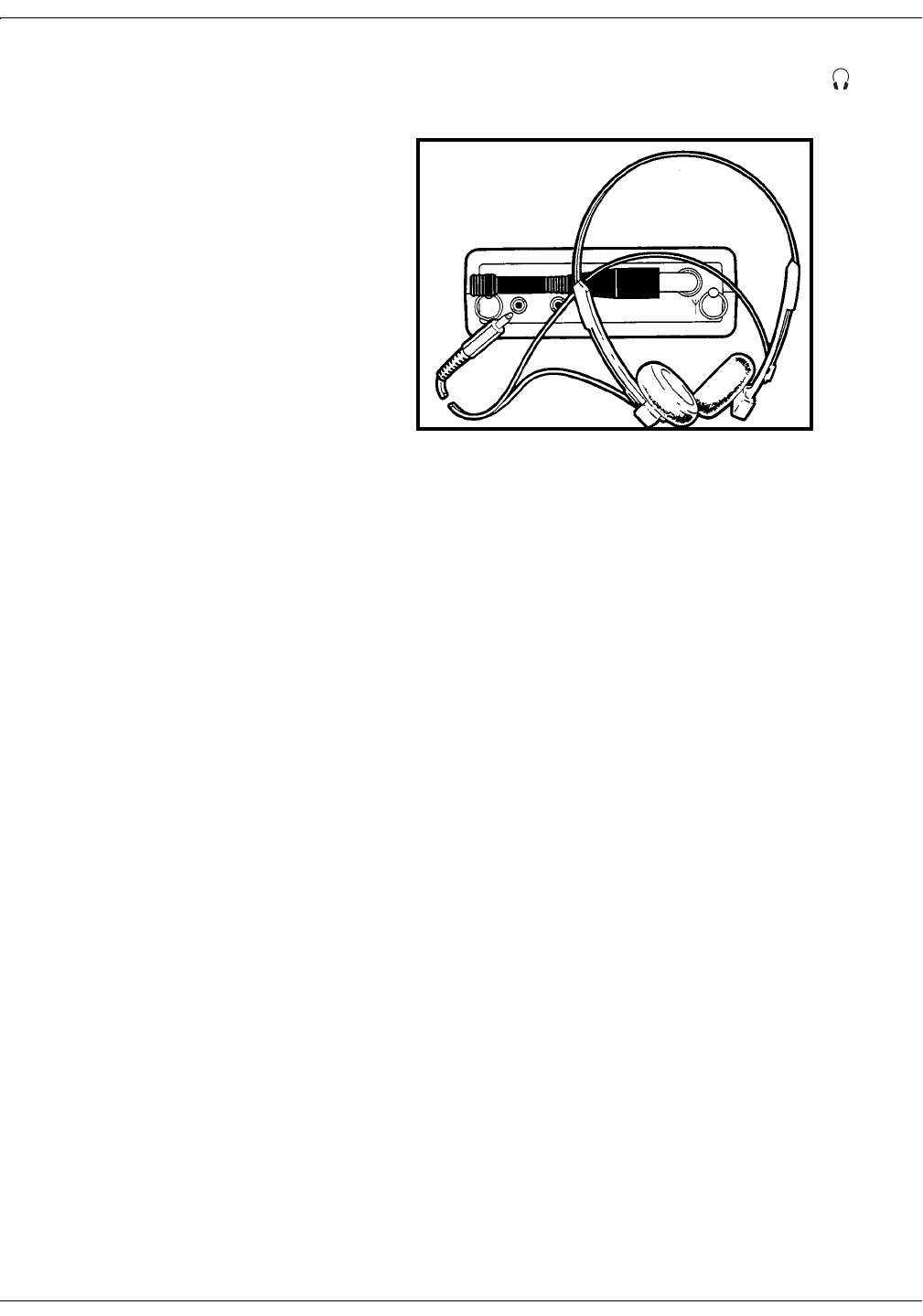
4-12 Model 340 Telemetry System Revision B
2003720-001
Setup Procedures: Performing a Functional Checkout
4. Plug the headset into the transmitter’s headset connector .
Figure 4-15. Connecting the Headset
5. Rub the face of the ultrasound transducer. Verify that you can hear
ultrasound audio tones from both sides of the headset.
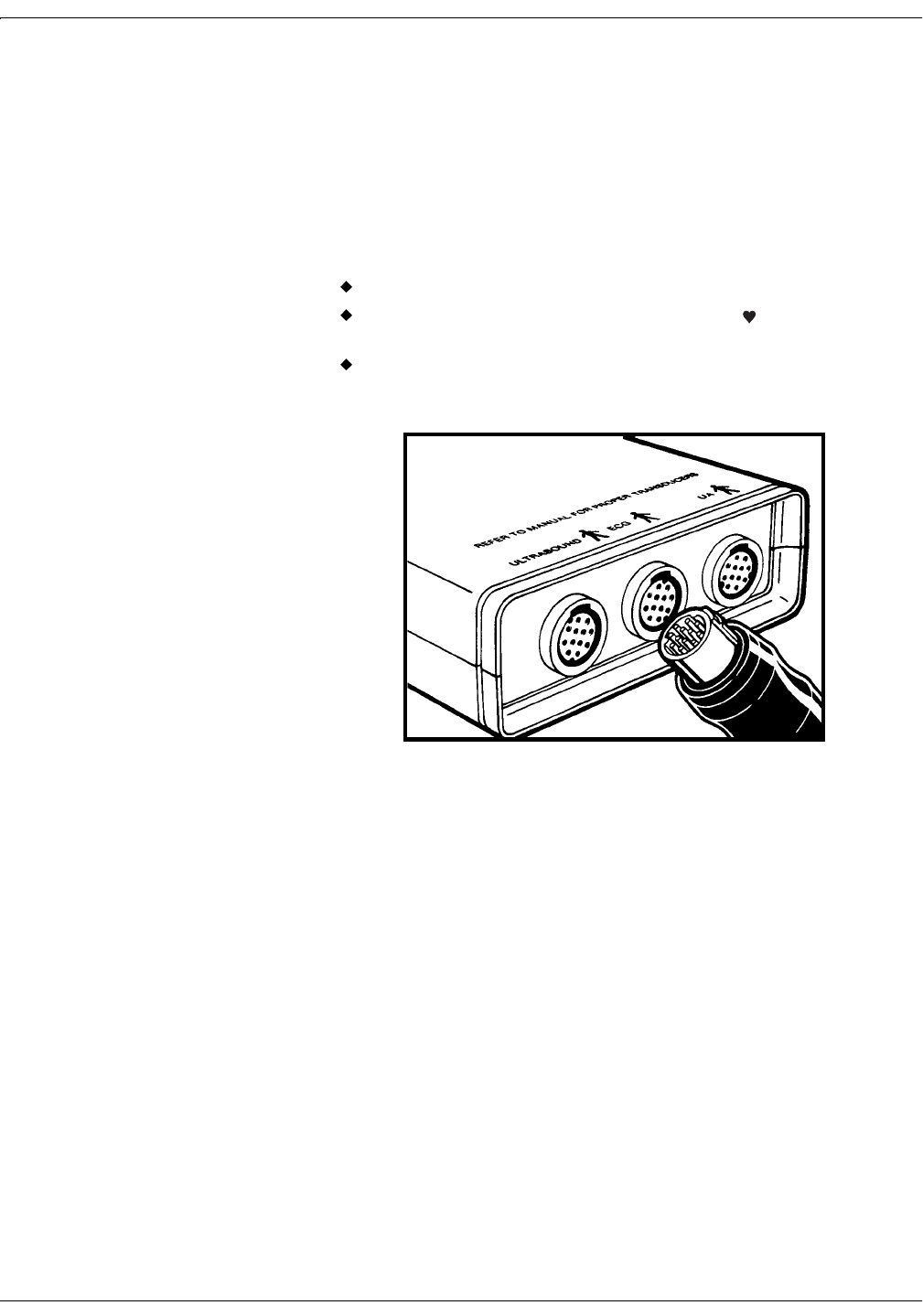
Revision B Model 340 Telemetry System 4-13
2003720-001
Setup Procedures: Performing a Functional Checkout
Testing the ECG Functions
127(Not all monitors have a
legplate tester. Refer to your
monitor’s operator’s manual for
complete information.
1. Slide the legplate into the monitor’s Legplate Tester jack and hold
firmly in place. (The legplate tester uses an internal ECG simulator
circuit for testing cable/legplate assemblies. The tester simulates a
signal of 120 BPM ± 1 BPM.)
2. Plug the other end into the ECG connector on the transmitter. Verify
the following on the monitor:
the corresponding FHR value reads 120 BPM;
the corresponding FHR heartbeat indicator flashes at a rate of
120 times per minute; and
the ECG “beep” is heard from the speaker.
Figure 4-16. Connecting an FECG Cable/Legplate

4-14 Model 340 Telemetry System Revision B
2003720-001
Setup Procedures: Performing a Functional Checkout
Testing the UA Functions
1. Place the receiver’s UA Mode Selector switch in the TOCO position.
,03257$17
TRIMLINE TOCOTRANSDUCERS—If the monitor is on
when you connect or re-connect a Trimline
Tocotransducer to the UA connector, you must wait at
least 10 seconds before pressing the UA Reference button.
If the monitor is off, you must wait at least 10 seconds
from the time the monitor is powered on.
2. Plug a tocotransducer into the transmitter’s UA connector. Verify the
following on the monitor:
If the monitor has a UA display: the display reads an arbitrary
pressure value.
If the monitor does not have a UA display: turn on the strip chart
recorder and check that TOCO prints on the paper’s mode
annotation line.
Figure 4-17. Connecting a Tocotransducer or IUPC Cable
,03257$17
DEFAULT REFERENCE VALUE—Most monitors have
a default UA reference of 10 relative units. Take into
consideration that newer model monitor’s can be
configured to store a custom default value.

Revision B Model 340 Telemetry System 4-15
2003720-001
Setup Procedures: Performing a Functional Checkout
3. Press the monitor’s UA Reference button to set the UA value to 10
relative units. Verify the following on the monitor:
If the monitor has a UA display: the display reads 10 relative
units.
If the monitor does not have a UA display: turn on the strip chart
recorder and check that the UA REF message and TOCO mode
annotation both print on the paper.
4. Apply gentle pressure to the tocotransducer pressure sensing button
and verify that the monitor (display or uterine activity trace)
responds to the pressure input. Increasing force should produce an
increasing value and vice versa.
If no pressure changes are recorded, ensure that the corresponding
interconnection cable is firmly attached to both the monitor and the
receiver.
5. This step applies to monitors which support IUP monitoring. Place
the receiver’s UA Mode Selector switch in the IUP position. Verify the
following on the monitor:
If the monitor has a mode indicator: the IUP mode should be
indicated.
If the monitor does not have a mode indicator: turn on the strip
chart recorder and check that the IUP mode annotation prints on
the paper.
127(Place the UA Mode Selector switch back in the TOCO position
unless you plan to monitor with an IUPC.

4-16 Model 340 Telemetry System Revision B
2003720-001
Setup Procedures: Performing a Functional Checkout
Testing the Remote Event Marker Function
1. Plug the Remote Event Marker into the transmitter’s Remote Marks
connector.
2. Turn on the monitor’s strip chart recorder.
3. Press the Remote Event Marker’s pushbutton for at least one second.
Verify that an appropriate mark is printed on the paper:
: This annotation is commonly used to record an “event.” This
mark is available on all Corometrics-brand monitors.
: This annotation is commonly used as an indication that the
mother has perceived fetal movement. (Refer to your monitor’s
operator’s manual to learn if your monitor supports this feature.
Refer to your monitor’s service manual for information about
enabling the option.)
Testing the Environment
Decide on which areas of your facility will be used for ambulatory
monitoring. Test each location separately to rule out rooms that are
restricted due to metal structures blocking signal transmission.
F
M

Revision B Model 340 Telemetry System 5-1
2003720-001
Chapter 5
Monitoring via Telemetry5
This section provides a brief overview of telemetry monitoring
procedures. Refer to the "Maternal/Fetal Monitoring Operator’s Manual"
for patient application information. Also refer to your monitor’s
operator’s manual.
Suggestions for Ambulatory Monitoring. . . . . . . . . . . . . . . . 5-2
Monitoring Reminders. . . . . . . . . . . . . . . . . . . . . . . . . . . . . . 5-3

5-2 Model 340 Telemetry System Revision B
2003720-001
Monitoring via Telemetry: Suggestions for Ambulatory Monitoring
Suggestions for Ambulatory Monitoring
,03257$17
DESIGNATED AREAS—Show the patient the areas that
are within signal range and where signal reception is
clear.
1. Instruct the patient to wear the Model 340T Transmitter with the
antenna pointed towards the Model 340R Receiver when possible.
2. Adjust the carrying strap to a comfortable length.
3. Encourage the patient to walk in a smooth, gliding motion. It is
preferable to slide feet rather than moving quickly which may cause
bouncing and artifact.
4. Instruct the patient, following each fetal movement, to listen via the
headset, for continued fetal heart rate tones.
127(Transducers with short
cables are available. Contact your
Information Technologies Sales
Representative.
5. Make sure the transducer cables are not dragging on the floor. If the
patient is in danger of tripping over the cables, drape them over the
patient’s arm; or shorten the length by taping a loop.

Revision B Model 340 Telemetry System 5-3
2003720-001
Monitoring via Telemetry: Monitoring Reminders
Monitoring Reminders
General
Use the correct interconnection method according to your monitor
model. See page 4-2 and page 4-5.
Remember to apply power to all three devices: monitor, receiver, and
transmitter.
Check that each interconnection cable is firmly attached to both the
receiver and the monitor.
As soon as any telemetry mode is detected, the front panel of the 120
or 170 Series Monitor is disabled and all front panel inputs are
ignored. In other words, telemetry and monitor modes cannot be
“mixed and matched”; you must use telemetry only or direct
monitoring only.
,03257$17
170 SERIES—For proper operation with a 170 Series
Monitor, disconnect all transducers from the front panel
of the monitor.
Ultrasound
Use only Corometrics 5700 Series ultrasound transducers with a
Model 340 Telemetry System.
Remind the patient to use the headset to check for continual pickup
of the fetal heart rate signal following each fetal movement.
FECG
You may need to tape the transducer cable to the patient to prevent
excessive tension on the legplate or attachment pad.
The recommended position for the legplate is on top of the upper
thigh instead of the inner thigh. This facilitates walking and
minimizes fluid contacting the legplate.

5-4 Model 340 Telemetry System Revision B
2003720-001
Monitoring via Telemetry: Monitoring Reminders
Tocotransducer
Remember to place the receiver’s UA Mode Selector switch in the
TOCO position.
When connecting or re-connecting a Corometrics Trimline
Tocotransducer to the transmitter’s UA connector, you must wait at
least 10 seconds before pressing the monitor’s UA Reference button. If
any device (monitor, receiver, transmitter is off), you must wait at
least ten seconds from the time the last device is powered on.
IUP
Remember to place the receiver’s UA Mode Selector switch in the IUP
position.

Revision B Model 340 Telemetry System 6-1
2003720-001
Chapter 6
Maintenance 6
All equipment, no matter how reliable, needs to be maintained on a
regular basis. This section describes general care and cleaning
instructions for the Model 340 Telemetry System.
General Cleaning Precautions. . . . . . . . . . . . . . . . . . . . . . . . 6-2
Cleaning the Transmitter and Receiver . . . . . . . . . . . . . . . . 6-3

6-2 Model 340 Telemetry System Revision B
2003720-001
Maintenance: General Cleaning Precautions
General Cleaning Precautions
127(Refer to your monitor’s
operator’s manual for cleaning
instructions for the monitor and
transducers.
&$87,21
SHOCK—Unplug the fetal or maternal/fetal monitor and
the Model 340R Receiver from the AC power source and
detach all accessories. Do not immerse accessories in any
liquid. Do not use abrasive cloth or cleaners on the
monitor, the Model 340R Receiver, the Model 340T
Transmitter, or any accessories.

Revision B Model 340 Telemetry System 6-3
2003720-001
Maintenance: Cleaning the Transmitter and Receiver
Cleaning the Transmitter and Receiver
1. Wipe any fluids from the surface of each unit.
2. Dampen a soft cloth with isopropyl alcohol and gently rub soiled area
until clean.
3. Dry with a soft, dry cloth.

6-4 Model 340 Telemetry System Revision B
2003720-001
For your notes

Revision B Model 340 Telemetry System 7-1
2003720-001
Chapter 7
Troubleshooting 7
This section of the manual provides a troubleshooting guide for the most
basic Model 340 operational problems. If the response to a specific
question is not found, contact the Service Department at one of the
following telephone numbers:
Inside the United States: Call 1-800-558-5120.
Outside the United States: Call 414-355-3790;
or contact your local distributor.
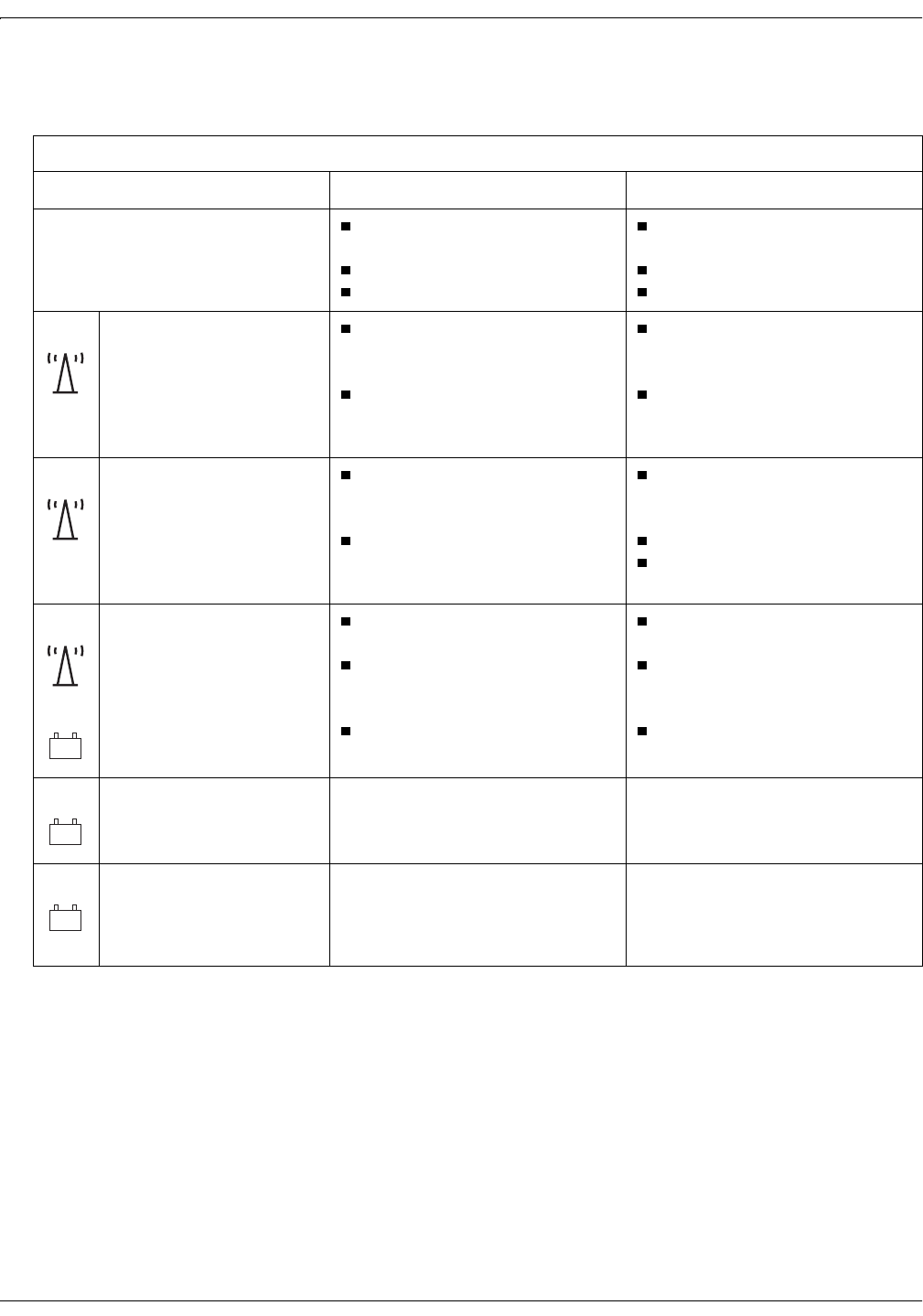
7-2 Model 340 Telemetry System Revision B
2003720-001
Troubleshooting: Problem Chart
Problem Chart
Table 7-1. Troubleshooting
Problem Probable Cause Solution
Receiver Power indicator does not light
when the receiver is turned on.
Receiver not connected to AC
receptacle.
Defective AC power cord.
Defective AC outlet.
Connect to AC receptacle.
Replace AC power cord.
Use a different AC outlet.
Signal indicator flashes with
transmitter turned on.
Transmitter batteries completely
discharged.
Mismatched transmitter and receiver
channels.
Replace batteries. Dispose of used
batteries according to the
manufacturer’s directions.
Ensure transmitter and receiver are
labeled with identical channel
numbers.
Signal indicator flashes
intermittently as patient
ambulates.
Patient outside signal transmission
range.
Metal in walls, doors, or other
structures between transmitter and
receiver.
Instruct patient to stay within signal
range and designated areas where
reception is clear.
Install optional ceiling antenna system.
Contact your Information Technologies
Service Representative.
Signal and Low Battery
indicators light with transmitter
turned off.
External source of radio frequency
interference is present.
Another transmitter with the same
frequency is use within the same
facility.
Service required.
Contact your Information Technologies
Service Representative.
Discontinue use of one of the
transmitters.
Contact your Information Technologies
Service Representative.
Low Battery indicator flashes
with transducers plugged into
transmitter.
Transmitter batteries have less than 10
minutes of energy left.
Replace the batteries. Dispose of used
batteries according to the manufacturer’s
instructions.
Low Battery indicator lights
continuously with no
transducers plugged into
transmitter.
Transmitter batteries are depleted. Replace the batteries. Dispose of used
batteries according to the manufacturer’s
instructions.
+
+
+

Revision B Model 340 Telemetry System 7-3
2003720-001
Troubleshooting: Problem Chart
Erratic FHR/UA recording.
Transducer not properly placed.
Transducer not properly connected to
transmitter.
Receiver interconnection cable(s) not
properly attached.
Receiver interconnection cable(s)
defective.
Wrong interconnection cable(s) in use.
Radio frequency interference.
Exceeding transmission range.
Shielding effect of hospital structure.
Reposition transducer.
Ensure the transducer is securely
attached to the transmitter.
Ensure interconnection cable(s) firmly
attached to both monitor and receiver.
Replace interconnection cable(s).
Verify interconnection method.
Instruct patient to stay within signal
range and designated areas where
reception is clear.
Install optional ceiling antenna system.
Contact your Information Technologies
Service Representative.
Monitor FHR and UA displays do not light
when transducers are plugged into
transmitter.
Monitor, transmitter, and/or receiver
off.
Receiver interconnection cable(s) not
properly attached.
Receiver interconnection cable(s)
defective.
Wrong interconnection cable(s) in use.
Ensure all three devices are turned on.
Ensure interconnection cable(s) firmly
attached to both monitor and receiver.
Replace interconnection cable(s).
Verify interconnection method.
Transmitter “chirps” every 4–5 seconds. Transmitter batteries have less than 10
minutes of energy left.
Replace the batteries. Dispose of used
batteries according to the manufacturer’s
instructions.
Table 7-1. Troubleshooting (Continued)
Problem Probable Cause Solution

7-4 Model 340 Telemetry System Revision B
2003720-001
For your notes

Revision B Model 340 Telemetry System 8-1
2003720-001
Chapter 8
Supplies and
Accessories 8
This section provides an overall listing of supplies and accessories for use
with a Corometrics Model 340 Telemetry System and with Corometrics
Fetal or Maternal/Fetal Monitors. To order any of the supplies and
accessories listed in this manual:
Inside the United States: Call 1-800-558-5120.
Outside the United States: Call 414-355-3790;
or contact your local distributor.
This chapter contains the following information:
General . . . . . . . . . . . . . . . . . . . . . . . . . . . . . . . . . . . . . . . . . . 8-2
Paper. . . . . . . . . . . . . . . . . . . . . . . . . . . . . . . . . . . . . . . . . . . . 8-3
Ultrasound . . . . . . . . . . . . . . . . . . . . . . . . . . . . . . . . . . . . . . . 8-4
FECG . . . . . . . . . . . . . . . . . . . . . . . . . . . . . . . . . . . . . . . . . . . 8-5
Tocotransducer. . . . . . . . . . . . . . . . . . . . . . . . . . . . . . . . . . . . 8-6
IUPC . . . . . . . . . . . . . . . . . . . . . . . . . . . . . . . . . . . . . . . . . . . . 8-7
MECG . . . . . . . . . . . . . . . . . . . . . . . . . . . . . . . . . . . . . . . . . . . 8-8

8-2 Model 340 Telemetry System Revision B
2003720-001
Supplies and Accessories: General
General
Table 8-1. General Supplies
Item Catalog Number (REF)
Detachable IEC AC Power Cord, United States Plug 1392AAA
Remote Event Marker, 8-foot Cord 3919BAO
Remote Event Marker, 5-foot Cord 3919CAO
Headset for Model 340 Telemetry System 3316AAO
Ultrasound Interconnect Cable (Models 115, 145 only) 1399AAO
Ultrasound Interconnect Cable (Models 116, 118, 150, 151, 155 only) 1399BAO
ECG Interconnect Cable (Models 115, 116, 118, 145, 150, 151, 155 only) 1375BAO
UA Interconnect Cable (Models 115, 116, 118, 145, 150, 151, 155 only) 1400AAO
Mark Interconnect Cable (Models 115, 116, 118, 145, 150, 151, 155 only) 1397AAO
System Interconnect Cable (Series 120, 170 only) 1563AAO
Remote Antenna Bracket with Extension Cable for Cart Use 1441AAO
Model 2116B Clinical-Notes/Data-Entry System 2116BAX
Model 3116 LDR/LDRP Bedroom Style Mobile Cart—Finished 3116AAO
Model 3116 LDR/LDRP Bedroom Style Mobile Cart—Unfinished 3116BAO
Model 146 Fetal Acoustic Stimulator 0146AAY

Revision B Model 340 Telemetry System 8-3
2003720-001
Supplies and Accessories: Paper
Paper
Table 8-2. Paper Supplies
Item Catalog Number (REF)
Z-Fold Chart Paper Pack, 30–240 BPM Heart Rate Scale (40/carton) 4305CAO
Z-Fold Chart Paper Pack, 50–210 BPM Heart Rate Scale (40/carton) 4305DAO
Chart Guard Label Packet 4914BAO

8-4 Model 340 Telemetry System Revision B
2003720-001
Supplies and Accessories: Ultrasound
Ultrasound
,03257$17
TRANSDUCER TYPE—Use only Corometrics 5700
Series Ultrasound Transducers. Do not use a Corometrics
5600 Series Transducer. The 5600 Series Transducers
are only for direct connection to a Model 115 or Model 145
Fetal Monitor or for use with a Model 320 or Model 330
Telemetry System.
Table 8-3. Ultrasound Supplies
Item Catalog Number (REF)
Loop-Style Ultrasound Transducer, 5-foot Cord 5700EAX
Loop-Style Ultrasound Transducer, 8-foot Cord 5700AAX
Loop-Style Ultrasound Transducer, 10-foot Cord 5700CAX
Button-Style Ultrasound Transducer, 5-foot Cord 5700FAX
Button-Style Ultrasound Transducer, 8-foot Cord 5700BAX
Loop-Style Ultrasound Transducer (Nautilus), 5-foot Cord 5700KAX
Loop-Style Ultrasound Transducer (Nautilus, 8-foot Cord 5700LAX
Loop-Style Ultrasound Transducer (Nautilus), 10-foot Cord 5700MAX
Button-Style Ultrasound Transducer (Nautilus), 5-foot Cord 5700GAX
Button-Style Ultrasound Transducer (Nautilus), 8-foot Cord 5700HAX
Loop-Style Ultrasound Transducer (Nautilus), 5-foot Cord 5700JAX
Ultrasound Coupling Gel Bottle, 250 ml (12/carton) 2434AAO
Ultrasound Coupling Gel Bottle, 5 liter 2475AAO
Reusable Belt for Loop-Style Transducer, Mesh Style (10/carton) 4425AAO
Reusable Belt for Loop-Style Transducer, Velcro Style (10/carton) 4425CAO
Reusable Belt for Button-Style Transducer, Elastic Style (10/carton) 4425EAO
Semi-Reusable Belt for Loop-Style Transducer, Velcro Style
(2/pack; 50 packs/carton) 4425FAO
Single-Patient Use Belt for Loop-Style Transducer,
Foam Style with Velcro Closure 8024AAO

Revision B Model 340 Telemetry System 8-5
2003720-001
Supplies and Accessories: FECG
FECG
Table 8-4. FECG Supplies
Item Catalog Number (REF)
Qwik Connect Plus Spiral Electrode (50/carton) 7000AAO
Legplate for Qwik Connect Plus Spiral Electrode, 8-foot Cord 1590AAO
Button-Style Legplate for Qwik Connect Plus Spiral Electrode, 8-foot Cord 1590CAO
Strap Adaptor for Qwik Connect Plus Spiral Electrode Legplates 1594AAO
ECG Conductive Cream Bottle, 118 ml (12/carton) 4514AAO
Reusable Legplate Strap with Velcro Closure (24/carton) 2023AAO
Single-Patient Use Legplate Strap 8036AAO

8-6 Model 340 Telemetry System Revision B
2003720-001
Supplies and Accessories: Tocotransducer
Tocotransducer
Table 8-5. Tocotransducer Supplies
Item Catalog Number (REF)
Loop-Style Tocotransducer (Nautilus), 5-foot Cord 2264KAX
Loop-Style Tocotransducer (Nautilus), 8-foot Cord 2264LAX
Loop-Style Tocotransducer (Nautilus), 10-foot Cord 2264MAX
Button-Style Tocotransducer (Nautilus), 5-foot Cord 2264GAX
Button-Style Tocotransducer (Nautilus), 8-foot Cord 2264HAX
Button-Style Tocotransducer (Nautilus), 10-foot Cord 2264JAX
Reusable Belt for Loop-Style Transducer, Mesh Style (10/carton) 4425AAO
Reusable Belt for Loop-Style Transducer, Velcro Style (10/carton) 4425CAO
Reusable Belt for Button-Style Transducer, Elastic Style (10/carton) 4425EAO
Semi-Reusable Belt for Loop-Style Transducer, Velcro Style
(2/pack; 50 packs/carton) 4425FAO
Single-Patient Use Belt for Loop-Style Transducer,
Foam Style with Velcro Closure 8024AAO

Revision B Model 340 Telemetry System 8-7
2003720-001
Supplies and Accessories: IUPC
IUPC
Table 8-6. IUPC Supplies
Item Catalog Number (REF)
Corometrics Softrans IUPC with Amnio Infusion/Sampling
Capabilities (10/carton) 2076AAO
Corometrics Softrans Intermediate Cable 1336AAO
Reusable Strain Gauge Pressure Transducer, 10-foot Cord
(with Holder) 4007BAX
Reusable Strain Gauge Pressure Transducer, 10-foot Cord
(without Holder) 4007LAX
Holder for Reusable Pressure Transducer 4516BAO
IUP Kit with Syringe for Reusable Pressure Transducer (50/carton) 2069AAO
Single-Patient Use Sterile Dome (10/carton) 5512AAO
Single-Patient Use Sterile Dome (120/carton) 5512BAO
Reusable Dome (5/carton) 5507AAO
Pressure Relief Valve for Pressure Transducer Dome (5/carton) 8070AAO
Disposable Strain Gauge Pressure Transducer (10/carton) 4009AAX
Holder for Disposable Pressure Transducer 4519AAO
Holder Assembly for Disposable Pressure Transducer 4518BAO

8-8 Model 340 Telemetry System Revision B
2003720-001
Supplies and Accessories: MECG
MECG
Table 8-7. MECG Supplies
Item Catalog Number (REF)
MECG Cable (round connector) for use with detachable leadwires, USA/AHA 1554AAO
MECG Cable (round connector) for use with detachable leadwires, Intl./IEC 1554BAO
Multi-Link Snap Leadwires, Set of 3, Grouped Detachable, 31 inches 411203-001
Multi-Link Snap Leadwires, Set of 5, Individually Detachable, 31 inches 411200-001
Multi-Link Grabber Leadwires, Set of 3, Grouped Detachable, 31 inches 412682-001
Multi-Link Grabber Leadwires, Set of 5, Individually Detachable, 31 inches 414556-001
Leadwire Adapter, 3-Lead Multi-Link to 3-Lead DIN 414371-001
Electrodes, Round, Foam, Pouches of 30, Case of 300 9431-004

Revision B Model 340 Telemetry System 9-1
2003720-001
Chapter 9
Technical Specifications9
127(Specifications are subject
to change without notice. This section contains a detailed list of the technical specifications for the
Model 340 Telemetry System.
This chapter lists specifications for the following:
Model 340T Transmitter . . . . . . . . . . . . . . . . . . . . . . . . . . . . 9-2
Model 340R Receiver . . . . . . . . . . . . . . . . . . . . . . . . . . . . . . . 9-4

9-2 Model 340 Telemetry System Revision B
2003720-001
Technical Specifications: Model 340T Transmitter
Model 340T Transmitter
Table 9-1. Model 340T Transmitter
Category Technical Specifications
Physical Characteristics
Height:
Width:
Depth:
Weight:
1.8 in (4.5 cm)
5.4 in (13.8 cm)
7.5 in (19.0 cm)
1.75 lbs (0.8 kg)
Environmental Conditions
Ambient Temperature:
Relative Humidity:
Atmospheric Pressure:
Operating Storage
50°F to 104°F (10°C to 40°C) 14°F to 131°F (–10°C to 55°C)
5% to 95%, non-condensing 5% to 95%, non-condensing
700–1060 mbar (525–795 mmHg) 700–1060 mbar (525–795 mmHg)
Certification and Compliance
UL:
FCC:
Industry Canada:
UL-544 Listed
Complies with FCC Part 90
Complies with RSS-119
Monitoring Modes
Fetal Heart Rate:
Uterine Activity:
Maternal Heart Rate:
Ultrasound (US) and Fetal ECG (FECG)
External Tocotransducer (TOCO) or Internal Intrauterine Pressure Catheter (IUPC)
Maternal ECG (MECG)
Ultrasound Mode
System:
Transmitter Frequency:
Intensity (Isata):
Pulse Doppler
1.151 MHz
<5 mW/cm2
ECG Mode
Input Impedance:
dc Tolerance:
Common Mode Rejection Ratio:
FECG Sensitivity:
MECG Sensitivity:
>1 GΩ
±1 V
>90 dB
20 µV to 1 mV
0.5 mV to 5 mV
TOCO Mode
Type:
Sensitivity:
Range:
Tocotransducer
20 µV/relative unit
–50 to +250 relative units
IUPC Mode
Type:
Sensitivity:
Range:
dc Strain Gauge
20 µV/mmHg
–50 to +250 mmHg
RF Section
Output Power:
Available Frequencies:
Channel Bandwidth:
10 mW
430–470 MHz
25 kHz
Transmission Range: 1640 ft (500 m), line of sight
Antenna Type: Flexible, detachable, BNC interconnect

Revision B Model 340 Telemetry System 9-3
2003720-001
Technical Specifications: Model 340T Transmitter
Batteries
Type:
Life: Four “AA” Alkaline Cells, 6.0 Vdc at 2450 mAh
20 h, approximatelya
Control: On/Off Switch
Audio Indicator: Low Battery
Connectors: Remote Event Marker Input, Headset Output
aUse of the headset will deplete the batteries more rapidly.
Table 9-1. Model 340T Transmitter
Category Technical Specifications

9-4 Model 340 Telemetry System Revision B
2003720-001
Technical Specifications: Model 340R Receiver
Model 340R Receiver
Table 9-1. Model 340R Receiver
Category Technical Specifications
Power Requirements
Nominal Line Voltage:
Line Frequency:
Power Consumption (maximum):
Chassis Leakage:
100–120 VAC 220–240 VAC
50/60 Hz 50/60 Hz
30 W 30 W
<50 µA
Physical Characteristics
Height:
Width:
Depth:
Weight:
3.2 in (8.1 cm)
7.4 in (18.8 cm)
11.4 in (29.0 cm)
7.0 lbs (3.2 kg)
Environmental Conditions
Ambient Temperature:
Relative Humidity:
Atmospheric Pressure:
Operating Storage
50°F to 104°F (10°C to 40°C) 14°F to 131°F (–10°C to 55°C)
5% to 95%, non-condensing 5% to 95%, non-condensing
700–1060 mbar (525–795 mmHg) 700–1060 mbar (525–795 mmHg)
Certification and Compliance
UL:
FCC:
Industry Canada:
UL-544 Listed
Complies with FCC Part 15
Complies with RSS-119
Output Signals: US, ECG, UA, and Mark
RF Section
Input Impedance:
Input Sensitivity: 50 Ω
<0.4 µV for 12 dB SINAD
Antenna Type: Flexible, detachable, BNC interconnect
(Other factory-approved external antennas or antenna systems may be used. Contact
your Information Technologies Service Representative for more information.)
Controls: On/Off Switch, UA Mode Switch
Visual Indicators:
Power:
Signal Strength:
Transmitter Low/Depleted Battery:
Green LED
Green LED
Red LED
Connectors
AC Line Input:
Mark Output:
Ultrasound Output:
ECG Output:
UA Output:
Auxiliary Output:
3-Prong, IEC-Style
Use only with Models 115, 116, 118, 145, 150, 151, and 155 Monitors.
Use only with Models 115, 116, 118, 145, 150, 151, and 155 Monitors.
Use only with Models 115, 116, 118, 145, 150, 151, and 155 Monitors.
Use only with Models 115, 116, 118, 145, 150, 151, and 155 Monitors.
Use only with Series 120 and 170 Monitors.
MANUAL P/N 2003720-001 REV
B
Ê2003720-001kŠ

